- Search Please fill out this field.
- Newsletters
- Destinations
- Maharashtra

Ajanta and Ellora Caves Essential Travel Guide
These Ancient Rock-Cut Caves are One of India's Top Historical Attractions
:max_bytes(150000):strip_icc():format(webp)/10947453_10153084623948270_8191342691038933499_o-591d1e8d3df78cf5fa731909.jpg)
TripSavvy / Anna Haines
Astonishingly carved into hillside rock in the middle of nowhere are the Ajanta and Ellora caves. Both are an important UNESCO World Heritage site.
There are 34 caves at Ellora dating from between the 6th and 11th centuries AD, and 29 caves at Ajanta dating back to between the 2nd century BC and 6th century AD. The caves at Ajanta are all Buddhist, while the caves at Ellora are a mixture of Buddhist, Hindu and Jain. Funds for the construction of the caves were provided by various rulers.
The incredible Kailasa Temple (also known as the Kailasha Temple), which forms Cave 16 at Ellora, is undoubtedly the most famous attraction. The temple is dedicated to Lord Shiva and his sacred abode at Mount Kailasha. Its immense size covers twice the area of the Parthenon in Athens, and is one and a half times as high! The life-size elephant sculptures are a highlight.
The most incomprehensible thing about the Ajanta and Ellora caves is that they were crafted by hand, with only a hammer and chisel. There are various cave complexes in India , but these are definitely the most spectacular.
Northern Maharashtra, around 400 kilometers (250 miles) from Mumbai.
Getting There
The closest railway stations are in Aurangabad for the Ellora caves (45 minutes away) and the industrial city of Jalgaon for the Ajanta caves (1.5 hours away). Travel time from Mumbai to Aurangabad by Indian Railways train is 6-7 hours. Here are the options.
There’s also an airport in Aurangabad, so it's possible to fly from many cities in India.
Using Aurangabad as a base, it’s most convenient to hire a taxi and drive between the two cave sites. It takes about three hours to get from Ellora to Ajanta.
Ashoka Tours and Travels , located on Station Road in Aurangabad, is popular and provides car hire to both Ellora and Ajanta. Depending on the type of car, rates start from 1,250 rupees for Ellora and 2,250 rupees for Ajanta.
Alternatively, Maharashtra State Road Transport Corporation conducts inexpensive daily guided bus tours to the Ajanta and Ellora caves from Aurangabad. The buses are comfortable air-conditioned Volvo buses. The tours run separately—one goes to Ajanta and the other to Ellora—and can be booked in advance at the Central Bus Stand and CIDCO Bus Stand.
- The Ajanta bus tour departs from the Central Bus Stand at 7.30 a.m. and arrives back at 5.20 p.m. The cost is 711 rupees per person.
- The Ellora bus tour departs from the Central Bus Stand at 8.30 a.m and arrives back at 5.30 p.m. It includes Daultabad Fort, Bibi Ka Maqbara and Panchakki. The cost is 276 rupees per person.
Or, if you'd prefer to travel independently, you can easily take a public Maharashtra State Road Transport Corporation bus from the Central Bus Stand in Aurangabad to Ellora (D0825) and Ajanta (D0647). It's worth considering, as you'll be able to get there before the tour buses do. The buses run frequently but they're not air-conditioned.
When to Visit
The best time to visit the caves is from November to March, when it's cooler and dry.
Opening Hours
The Ellora caves are open from sunrise until sunset (around 5:00 p.m.), daily except Wednesdays. The Ajanta caves open from 9 a.m. until 5 p.m., daily except Mondays. Both caves are open on national holidays. However, try to avoid visiting them then (as well as on weekends) as the crowds can be overwhelming and you won't have a peaceful experience.
Entrance Fees and Charges
Visiting both the Ajanta and Ellora caves is costly for foreigners. The sites require separate tickets and the price is 600 rupees per foreign visitor. Indians pay only 40 rupees per ticket at each site. Children younger than 15 years are free at both places.
Ajanta and Ellora Visitor Centers
The visitor centers provide information about the two heritage sites using audiovisual media.
The Ajanta Visitor Center is the larger of the two. It has five museum halls with replicas of the four main caves (1, 2,16 and 17). The Ellora Visitor Center has a replica of the Kailasa Temple. Both visitor centers also have restaurants, amphitheaters and auditoriums, shops, exhibition space, and parking.
Unfortunately, the visitor centers are located some distance away from the caves and the replicas have failed to draw the expected number of tourists. In August 2018, Maharashtra Tourism announced that substantial funding had been allocated to enhance them and provide a better experience.
Where to Stay
Hotel Kailas is located right opposite the Ellora caves. It's a relaxing, tranquil place with stone walls and a scenic landscape, albeit simply furnished accommodations. Rates are 2,300 rupees for a non air-conditioned room, 3,500 rupees for an air-conditioned cottage, and 4,000 rupees for an air-conditioned cottage facing the caves. Tax is additional. The hotel has plenty of amenities for guests including a restaurant, internet access, a library and games. You can also go paragliding.
Quality accommodations at Ajanta are limited so if you need to stay in the area, it's best to head to the Maharashtra Tourism Development Corporation's Ajanta T Junction Guest House (rooms from 1,600 rupees per night) or Ajanta Tourist Resort in nearby Fardapur (1,700 rupees per night).
If you prefer to stay in Aurangabad, Hotel Panchavati is a clean and comfortable budget option near the railway station and bus stand.
Should You Visit Ajanta or Ellora?
While the Ajanta caves have some of India's most sophisticated ancient paintings, the Ellora caves are renowned for their extraordinary architecture. Both the caves have sculptures.
Don't have time or money to visit both caves? Ellora receives about twice as many tourists as Ajanta, as it's more accessible. If your itinerary forces you to choose between the two sites, base you decision on whether you're more interested in the art at Ajanta, or architecture at Ellora. Also take into consideration the fact that Ajanta has an outstanding setting overlooking a gorge along the Waghora River, making it more enjoyable to explore.
Travel Tips
- You can get an excellent view and perspective of inside the Kailasa Temple at Ellora by climbing up the hill around it.
- When visiting Ajanta, ask your driver to drop you at the viewpoint and meet you at the car park. Walk downhill from the viewpoint and enter at cave eight. From there, walk right to the end and start at cave 28. This will enable you to see nearly half the caves without the crowds.
- Bring a torch with you to the caves as many of them are quite dark and lighting is poor.
- Try to reach the caves before 10 a.m. to beat the crowds and tour buses.
Dangers and Annoyances
Security was increased at the Ellora caves in 2013, following incidents of tourists being sexually harassed by groups of young Indian guys. This has been effective in improving safety. However, tourists still need to be aware of harassment from hawkers and touts that charge inflated prices.
Maintenance and cleanliness has improved at both the Ajanta and Ellora caves in recent years. The caves are now being looked after by a private company under the Indian government's "Adopt a Heritage Site" program.
A three-day Ellora-Ajanta International Festival is organized by Maharashtra Tourism each year. It features some of India's most distinguished musicians and and dancers.
Related Articles
More related articles.
Ajanta and Ellora Caves – The Essential Guide

It has been more than a year since I posted on the blog , so I thought I should remedy that. And what better way to start than with one of my most recent trips. In January this year, I visited Aurangabad and obviously went to Ajanta and Ellora Caves. My last trip to these UNESCO World Heritage Sites was many (many) years ago, when I was still in school, so I was excited to revisit. Here’s everything you need to know if you’re planning a trip.

Ajanta Caves

These include both monasteries (chaityas) and worship-halls (viharas). They are adorned with rock-cut sculptures and paintings that represent some of the finest examples of ancient Indian art.
Cave 1 is the most beautifully decorated and contains many of the iconic Ajanta artworks like the Padmapani mural (top right). Amongst the oldest in the complex, cave 10 contains a massive prayer hall with rows of octagonal pillars on either side and a stupa at the end. Caves 16 and 17 have some of the best-preserved and well-known paintings of all the Ajanta caves, depicting elaborate narratives from the Jataka tales.

One of my favourites is Cave 26, which has intricate sculptures including that of the reclining Buddha (below) and the legend of “Temptations by Mara”.
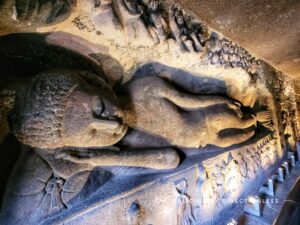
Ellora Caves
Unlike Ajanta, Ellora comprises Buddhist, Hindu, and Jain religious centres spread over 34 caves dating between the 6th and 11th centuries AD. Of these, cave 16 is the most spectacular, featuring the Kailasa temple. This chariot-shaped monument dedicated to Shiva is the largest single monolithic rock excavation in the world.

Apparently, 10 generations of artisans worked on it and it took more than 200 years to complete over many reigns of the Rastrakuta kings. It has all the main temple elements such as gateway, main shrine, nandi shrine, etc. It is richly carved with niches, pilasters, windows, and corniches. One of the highlights are the friezes on the plinth that illustrate the two great epics — Ramayana and Mahabharata.
You will need at least two hours to explore the entire temple, and believe me, it’s worth it! I would also recommend climbing up a pathway that skirts the cave for an aerial view of the temple. You will get a better idea of its sheer size and grandeur (see below).

Other than cave 16, you should also check out two Buddhist caves. Cave 5 has a uniquely designed hall with a pair of parallel refectory benches in the centre and a Buddha statue in the rear. Cave 10 has a cathedral-like stupa hall and a 15-foot statue of Buddha seated in a preaching pose.
The Jain caves (nos. 30-34) are some distance away and we skipped them as we had to return to the city.
How to visit Ajanta and Ellora Caves

Where to eat
Since both the caves are a day trip from Aurangabad, you will need to grab lunch nearby. There’s an MTDC canteen of sorts at Ajanta but I’d suggest you head to Hotel Ajanta Green (also run by MTDC), which is located a couple of kilometres from the caves. Near Ellora caves, your best bet is the restaurant Kailasa, which is just outside the cave complex.
When to visit

November to March is the best time to visit the caves when it is (relatively) cool and dry. The summer months can be scorching and also crowded because of school holidays. The caves are open during the monsoon but I would imagine the paths would be slippery, particularly at Ajanta where you have to climb up and down some steep rock-cut stairs. However, our guide said that the rains make the setting quite spectacular with greenery and waterfalls (the pic on the left was taken in Jan 2023).
How to travel to Aurangabad

Where to stay in Aurangabad
There are several hotels in the city, but since I was travelling with family (and we were staying for four nights), we opted for an apartment. We found this lovely two-bedroom apartment on Booking.com , which was clean, well-appointed, and reasonably priced. Its location was also quite convenient, just over 3km from the railway station (and under 1okm from the airport).
Have you visited Ajanta and Ellora Caves? If not, I hope this post inspires you to go soon!
This Mumbai Walking Tour Is An Architectural ...
Guide to aurangabad (chhatrapati sambhaji nagar), related posts.
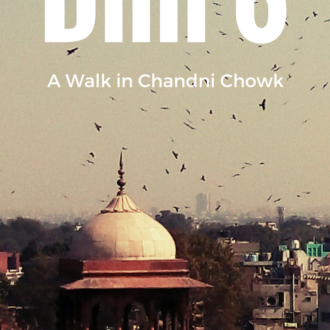
Walk through Chandni Chowk, plus where to stay in Delhi

Suryagarh – A Royal Stay in Jaisalmer
Leave a reply cancel reply.
Your email address will not be published. Required fields are marked *
Yes, add me to your mailing list.
This site uses Akismet to reduce spam. Learn how your comment data is processed .
- Search Search Search …
- Search Search …

How to Visit Ajanta and Ellora [One Day Itinerary]
When we booked it this seemed like a good idea. Taking a series of three overnight flights from Kathmandu to Delhi, then to Mumbai and from there to Aurangabad, so that we could spend the day visiting the UNESCO world heritage Ajanta and Ellora caves. Remind me of this in the future.
We arrived at Aurangabad airport at 06:15. We left Kathmandu at 14:00 yesterday and in the meantime have been to both Delhi and Mumbai airports We spent most of the night outside check in at Mumbai Airport. It was NOT a good way to get here.
However, don’t let that put you off coming to Ajanta and Ellora.
THIS POST MAY CONTAIN COMPENSATED AND AFFILIATE LINKS MORE INFORMATION IN OUR DISCLAIMER
How to Visit Ajanta and Ellora in a Day
We pre-booked a car and driver using the TripAdvisor forum. Mr Taqui Hussein picked us up from the airport, drove us to Ajanta, then Ellora, and finally dropped us outside the Railway Station in Aurangabad. He was fabulous. We paid 3,500 INR for the full day, including any parking charges. Our route took us to the Ajanta Caves for opening time, then back to Ellora and we were dropped off at the Aurangabad Railway Station at the end of the day. Our total distance was 230 kilometers.
EASIEST WAY TO VISIT

Take a Private Tour to Ajanta & Ellora
We found the easiest way to see both Ajanta and Ellora in the same day was to take a private tour, and this is the best tour we’ve found to see Ellora and Ajanta caves and temples.
Visiting Ajanta & Ellora as a day trip
If you’d like to see Ajanta and Ellora – then you can take a day trip from Aurangabad – with a driver and English-speaking guide, plus an air-conditioned car. Check out the options here .
It always feels like we’re cheating when we arrange a car and driver, but this is only the second time we’ve done this in India, so I think we’re excused! The reason for the overnight flight, and trying to see Ajanta and Ellora in one day is that our time frame has changed. We need to be back in Bengalaru for an Indian wedding, so we have a GREAT reason to step things up!
How to Go from Aurangabad to Ajanta
It’s 100 kilometers, or around 2.5 hours from Aurangabad to Ajanta. Aurangabad is the closest town that we could fly to. We managed a quick stop for breakfast on the way before arriving at Ajanta at opening time.
You can head to Ajanta on a day trip from Aurangabad – and also take in Ellora – there are more details here.
What to See at The Ajanta Caves
Since 1983 the Ajanta Caves have been a UNESCO World Heritage Site. The Indian Archeological Society describes them as the “finest surviving examples of Indian art, particularly painting”. The caves date from 400 BC and contain Buddhist religious art and Jataka depictions. The Jataka are native to India and tell the stories of the previous lives of the Buddha. There are about 30 caves cut into a cliff in a gorge above the river Waghur.

Ajanta was rediscovered by accident by a British hunting party in 1819. It’s thought that the paintings are related to the gorgeous Sigiriya in Sri Lanka. You can read our guide about visiting Sigiriya here .
How to Access Ajanta Via Bus
Mr Hussein drops us in the car park, where we head to the buses. It’s not exactly busy here, so while the sign might say that there are AC buses, there aren’t. But there’s a breeze, so the open window works reasonably well. The bus up to the bus park by the caves doesn’t take long. And its not even worth considering walking to save the 15 INR that the bus costs, unless of course, you’re nuts in this heat.

Cost of Ajanta Caves Tickets
We buy a ticket here for 250 INR, the Foreign Tourist price. There are guides available, pricing depends upon the size of your group, but we stick with the Indian Archeological Society notes we’ve downloaded. From here it’s all walking.
Exploring The Ajanta Caves Site
The caves are located in the cliffs on a bend in the river. It’s a horseshoe shaped gorge. The site itself is lovely. The paths are well maintained and the signage is great. If there’s a large tour group anywhere near you, then stop and wait until they pass, it’s well worth the solitude.
Tips for Visiting Ajanta Caves
- Take water with you. There is water available at the restaurant by the ticket office, but not once you leave there.
- The restaurant by the ticket office does a great thali for lunch and looked much cleaner than the places near the car park.
- Take a hat or an umbrella, outside the caves the sun is amazingly strong and reflects off the rocks.You will need to remove your shoes to visit some caves, so consider your footwear. The paths are in good condition, but there are some steps/uneven areas and it’s a little slippery.
- Remember the Camera! There are several viewpoints throughout the site – we didn’t make it to the high one because of the heat, but it didn’t detract from the fact that this is an incredible site and reasonably well preserved.
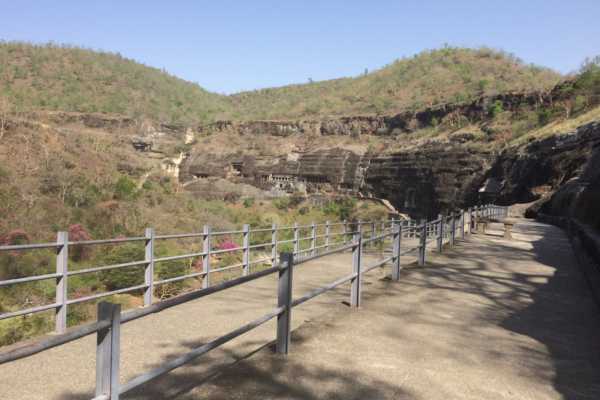
Ajanta Cave One
This (and cave two) are the most beautifully painted caves here. There are fragments of the paintings left and they are quite stunning. Try and visit when they’re empty of people. You can take photographs but there is no flash photography.

Ajanta Cave Two
Be sure to look up when you walk around this cave. The ceiling paintings are just spectacular. It is incredible to see the brightness of the colours and consider their age.
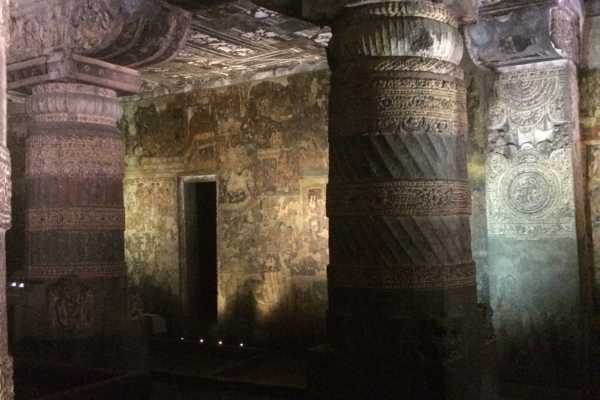
As you walk around the gorge, it really is a simply stunning spectacle. You’ll stop each time you come out of a cave, slip your shoes back on, and just, well, look.

The paintings are simply gorgeous, the caves are incredible and this is well worth a visit, but we must move on. We have a quick thali and a cold drink at the restaurant by the ticket office and then head back on the bus to the car park.
How to Go from Ajanta to Ellora
It takes nearly two hours to drive to Ellora, its back in the direction of Aurangabad, so we’ll be close to our final destination for the day when we’re finished.
How to Visit the Ellora Caves and Temples
We arrived at the Ellora Caves area by 14:00. It was pretty hot and pretty busy too, so we took the advice of Mr Hussein to focus our time here. Ellora is also a UNESCO World Heritage Site and combines Hindu, Buddhist, and Jain temples and caves. There are 17 Hindu caves, 12 are Buddhist and 5 are Jain. They’re all in amazingly close proximity and were carved and built between the 5 th and 10 th centuries.
We headed to the biggest cave first. This is Cave 16.
The Kailasa Temple, Ellora
The Kailasa Temple, or Cave 16, is dedicated to Shiva. It looks more like a multi-storey temple complex but was actually carved out of a single piece of rock. This area is twice the size of the Greek Parthenon in Athens. It is VAST.

The Dashavatara, Ellora
This is also known as Cave 15. These caves are so very different from Ajanta. They’re much bigger for a start. The ones that we visit have multiple storeys to them and, while this cave was started as a Buddhist monastery, this is now a Hindu cave.
We managed to visit several of Buddhist and Jain caves too.
The carving here is spectacular, and the sheer size is amazing. The crowds lessen as we move to the smaller temples, but it’s so very hot and we spent the night outside an airport. The cool relief of the caves is marvelous. If you make it here, be sure to go to the smaller caves, get away from the crowds, and walk through the seeming maze of different routes.
How to Go from Ellora to Aurangabad
At the end of the day, Mr Hussein dropped us off at the Hotel Preetam in Aurangabad. We selected this place because, if you were any closer to the train station you’d be sleeping on the tracks. We have a 06:00 train tomorrow, to Nashik, where we’re going Wine Tasting India style.
USING TRAINS IN INDIA
The Best Way to Book Indian Trains
The easiest and best way to book trains in India as a foreign visitor is to use 12goAsia. You’ll always get confirmed tickets and foreign cards are accepted.
UNESCO Sites to Visit in India
If you like visiting UNESCO World Heritage Sites, then you’ll love our guides to India’s best World Heritage sites
- Champaner Pavagadh, in Gujarat
- The Taj Mahal in Agra
- The Ajanta Caves
- Ellora Caves
- Khajuraho’s Temples
- Humayun’s Tomb, Delhi
- The Hill Forts of Rajasthan
- The Darjeeling Hill Railway
- Qutub Minar in Delhi
- The Mahabodhi Temple in Bodhgaya
- Mahabalipuram
Travel Tips for Exploring India
- Considering travel insurance for your trip? World Nomads offers coverage for more than 150 adventure activities as well as emergency medical, lost luggage, trip cancellation, and more.
- Get online immediately with an eSIM for India
- Protect your data – use a VPN in India – use this coupon to get 3 months free.
- Book the best tours and guides in India on GetYourGuide or Klook
- Find the right accommodation for you via Booking.com
- Book Trains and Buses in India with 12goAsia
- Where we stayed in Aurangabad – the Hotel Preetam
- Our next stop after Ajanta and Ellora Caves was Wine Tasting India Style in Nashik
We receive a fee when you get a quote from World Nomads using our affiliate links. We do not represent World Nomads. This is not a recommendation to buy travel insurance.
ASocialNomad is a participant in the Amazon Services LLC Associates Program, an affiliate advertising program designed to provide a means for sites to earn advertising fees by advertising and linking to amazon.com, amazon.co.uk, and amazon.ca. Amazon and the Amazon logo are trademarks of Amazon.com, Inc. or its affiliates. As an Amazon Associate, I earn from qualifying purchases .
Sarah Carter
Leave a comment cancel reply.
Your email address will not be published. Required fields are marked *
Save my name, email, and website in this browser for the next time I comment.
2 thoughts on “ How to Visit Ajanta and Ellora [One Day Itinerary] ”
- 2 comments
Wow Sarah your travels sound amazing! I love watching the Amazing Race here in the U.S. but don’t always want to go everywhere they are. I doubt I will ever get into the areas of India you traveled but truly enjoy reading and seeing your photos! Travel on!
Thanks so much! Sometimes I think we should change our tagline to be “we go there, so you don’t have to” 😉 India is well worth the trip, but she’s a hard country to travel in as a western woman.
Privacy Overview

- Heritage & Culture
Ajanta And Ellora Caves – The Complete Travel Guide
Explore Ancient Indian History At The Magnificent Ajanta And Elora Caves

Recognized as the gems that represent Indian history displaying impressive artistry of the foregone era, the Ajanta and Ellora Caves consist of 64 rock-cut caves, located nearby from the city of Aurangabad. History states that the Ajanta caves were made between the second century BCE till 650 or 480 CE, whereas those of Ellora were made between the 5th century CE and 10th century CE. Today the caves are UNESCO World Heritage Site and are on the bucket list of travelers and history buffs from different parts of the world. So if they are on your bucket list as well, here’s a complete guide to making your trip stress-free.
How To Get There
The caves are situated in Northern Maharashtra which is around 400 kilometers from Mumbai and owing to their popularity are also easily accessible by various modes. Here are a few details for a hassle-free exploration.
- By train – The closest transportation service can be found via the Aurangabad railway stations. The caves of Ellora are only at a 45 minutes distance while those in Ajanta are 1.5 hours away. You can travel from Mumbai till Aurangabad in just 6 or 7 hours. The fastest train is the Dadar – Jalna Jan Shatabdi Express that takes around six hours and ten minutes. Once you reach the Aurangabad Railway Station, you can book a taxi from Aurangabad to Ajanta Ellora and reach your destination in no time.
- By Flight – You will need to travel to Aurangabad airport and the caves are at a distance of 100 km from the airport. The airport is well connected with major cities in India.
- By Road – Aurangabad is easily reachable via road from different neighboring places like Mumbai, Hyderabad, Aurangabad, and Ahmedabad. You may take a bus or travel in your car to the caves.
Key Attractions Of The Ajanta And Ellora Caves
The caves are historical and architectural marvels and are a treat to witness. Let us introduce you to these archaeological gemstones.
Ajanta Caves
Ajanta Caves comprise 30 rock-cut caves, displaying a portion of the finest works of art and figures at any point recorded in Indian history. However, the ones you shouldn’t miss out on are Cave 1, Cave 2, Cave 4, and Cave 17.
Cave 1 is the standout amongst all the caves mainly because the artwork depicted on its walls is authentic. It has a grand doorway which is adorned with Bodhisattva murals and the sidewalls depict two important phases in Buddha’s life, the moment before his enlightenment and when he turned himself into many images. Cave 2’s ceiling has intricate abstract and mind-boggling designs of devils, birds, fruits, and flowers making it the highlight. one of the biggest religious communities in Ajanta Cave 4 is known to still give off a magical vibe, despite being an incomplete creation.

Ellora Caves
Comprising of 34 caves, having its unique, the Ellora Caves are a marvel to behold. It might not be possible for you to visit them all hence we recommend Cave 1, Cave 2, and Cave 16 especially if you are short on time and don’t want to miss out on the best ones.
Cave 1 a Buddhist temple also known as a Vihara and highlights 8 religious cells. Home to 12 ornate pillars and Lord Buddha seated on a lion Cave 2 is also an impressive location. A carving of Maitreya Buddha, along with Padmapani holding a lotus adorned its glorious doorway. Cave 16 or Kailesh temple is an important pilgrimage spot for the followers of Lord Shiva. The gopurams here which is a large pyramidal tower signify Mount Kailash which is the abode of Lord Shiva.

Things You Can Do On Your Visit
If you want to do things besides visiting the caves, here are a few fun things you can do on your visit.
Ajanta Ellora Festival
Organized annually in November The Ajanta and Ellora Festival by the Maharashtra Tourism Development Corporation attracts travelers from across the world. Dance and music performances, increase the charm of the caves. The festival showcases the talent of the young folk and classical artists, along with the craftsmanship and architectural brilliance of the monuments in Aurangabad.
Splurge On Paintings
Shopping and travel go hand in hand, and the Ajanta and Ellora caves allow you plenty of opportunities to enjoy the joys of shopping. There are many open-air markets where you will come across beautiful Buddha sculptures handcrafted by the local artisans, along with semi-precious stones and silver ornaments, footwear, clothing.
Few Tips For A Wholesome Trip
- Make sure you have a guide when you are exploring because every painting and sculpture in the Ajanta and Ellora has a story and without one, you will not be able to appreciate their significance.
- Inside the Kailasa Temple at Ellora and climbing up the hill around it will let you be privy to an excellent view.
- When visiting Ajanta, ask your driver to drop you at the viewpoint and meet you at the car park. Walk downhill from the viewpoint and enter cave eight. From there, walk right to the end and start at cave 28. This will enable you to see nearly half the caves without the crowds
- Many of the caves are quite dark and the lighting is poor so make sure to carry a flashlight.
- Reach the caves early, preferably before 10 am to avoid crowds.
Also Read: Photographers’ Top 6 Favorite Destinations In India
Experience Beauty Of The Wonder Years
The best time to visit Ajanta Ellora Caves is June to March as the pleasant weather makes the exploration a delight. Till September the region receives an average of plenty of rain showers, which also make for a beautiful day. The caves have a historical significance which attracts tons of history buffs and if you wish to connect to the past these caves make the perfect destination. So the next time you wish to experience the deep-rooted history of India, do visit the Ajanta and Ellora caves for a fulfilling experience.
LEAVE A REPLY Cancel reply
Save my name, email, and website in this browser for the next time I comment.
Unveiling the wonders of culture and tradition!

Are you ready to embark on a journey filled with adventure, culture, tradition, and exciting attractions? Let your explorer's spirit soar and make unforgettable memories as you explore the beauty of our diverse world.
Best Time To Visit Ajanta and Ellora Caves
View hotels for your date, travel essentials.
Ideal duration: 1-2 days
Best Time: June to March Read More
Planning a Trip? Ask Your Question
Ajanta and Ellora Caves
What is the best time to visit ajanta and ellora caves.
June to March are the best months to visit Ajanta and Ellora Caves. It becomes a little difficult to travel around and explore the caves in summers April-May. Winters and Monsoon are ideal as the climate is pleasant from October to March and June to September which is the best time to visit the caves. Avoid summers if you don't want the sun to bother you while you are enjoying your archaeological journey. The scorching heat of April and May makes it a bit challenging for the tourists.
Weather in Ajanta and Ellora Caves

Upcoming Ajanta and Ellora Caves Weather
Monthly weather in ajanta and ellora caves, top hotels in ajanta and ellora caves.
7.7 (182 reviews)
₽ 3,107 onwards
7.6 (202 reviews)
₽ 1,997 onwards
8.4 (20 reviews)
₽ 2,884 onwards
7.8 (6 reviews)
₽ 3,416 onwards
5.2 (4 reviews)
₽ 1,664 onwards
3.0 (3 reviews)
₽ 1,357 onwards
More about Best Time to Travel to Ajanta and Ellora Caves
Ajanta and ellora caves in winter (october - february).
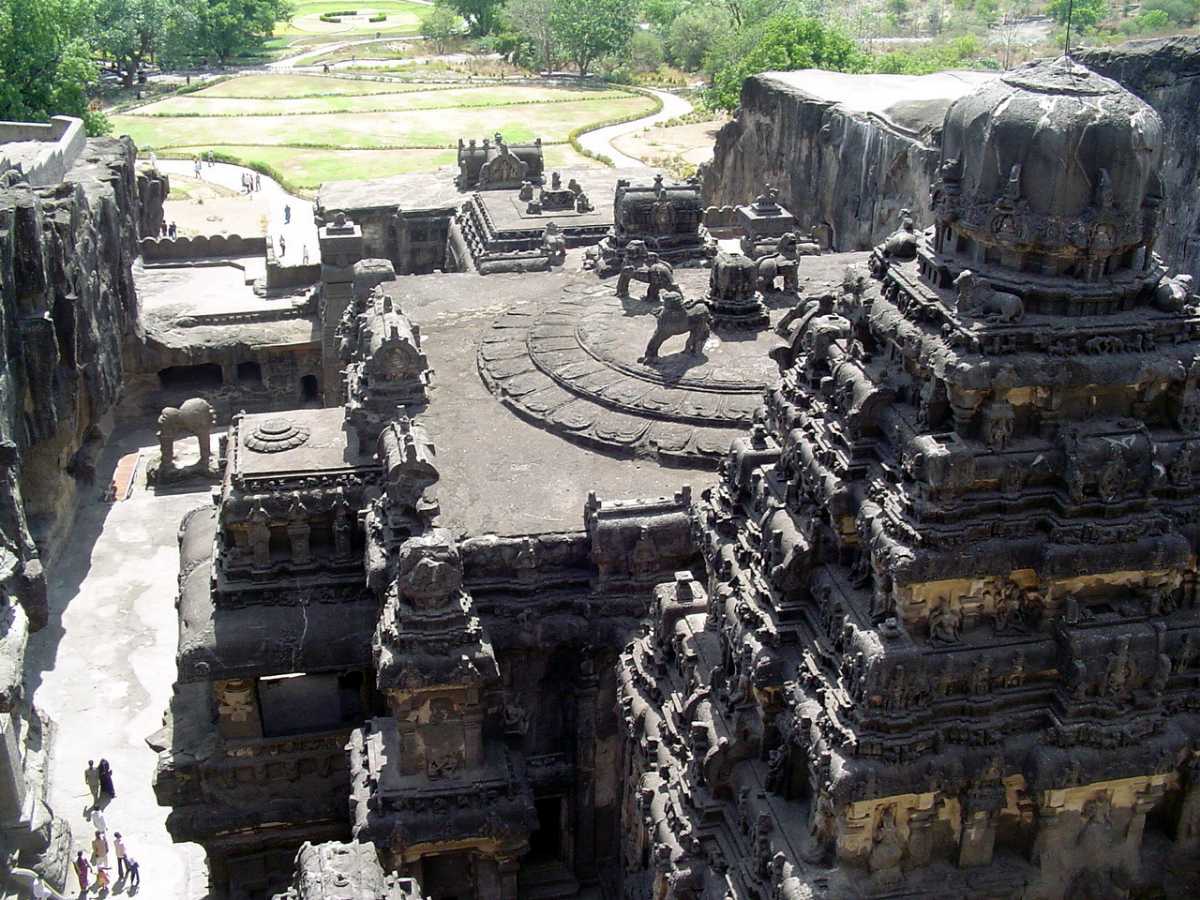
Ajanta and Ellora Caves in Monsoon (June - September)
Weather June brings refreshing monsoon to Ajanta and Ellora, drenching the region in lush green beauty. The South-west monsoon winds bring abundant rains to the region, drastically changing the landscape from an arid, dry region to green vastness. The monsoon is not very intense in Aurangabad though– travel is rarely impaired on account of the monsoon. This is the first tourist season in Ajanta and Ellora – you can expect a large influx of tourists although the caves are rarely very crowded. With temperatures ranging between 22°C and 32°C, the weather is pleasant. The interiors of the caves become cooler as well, enhancing the experience. The rocky façades of the caverns look even more delightful in the rain. The verdant vegetation enriches the beauty and magic of the caves. Things to Do Walk around the Viharas and pillars of Ajanta, and admire the stone carvings and murals at Ellora in the monsoon, as the sounds of the rain play second fiddle. As you approach September, the rains decrease, and the weather gets even more comfortable. A key festival to watch out for at Ajanta and Ellora during the monsoon is Ganesh Chaturthi – the birthday of the Hindu God Ganesha. All revere this elephant-faced god as the harbinger of good luck and prosperity. Huge idols of Ganesha are taken in procession, and the festivities are delightful to watch. Do not forget to snack on modaks, the sweet offering of coconut, jaggery and rice! This is the ideal time for families to visit Ajanta and Ellora, as there are ample places to visit. Shopping may get comparatively more expensive now because of high demand, but feel free to bargain until you can strike a deal.
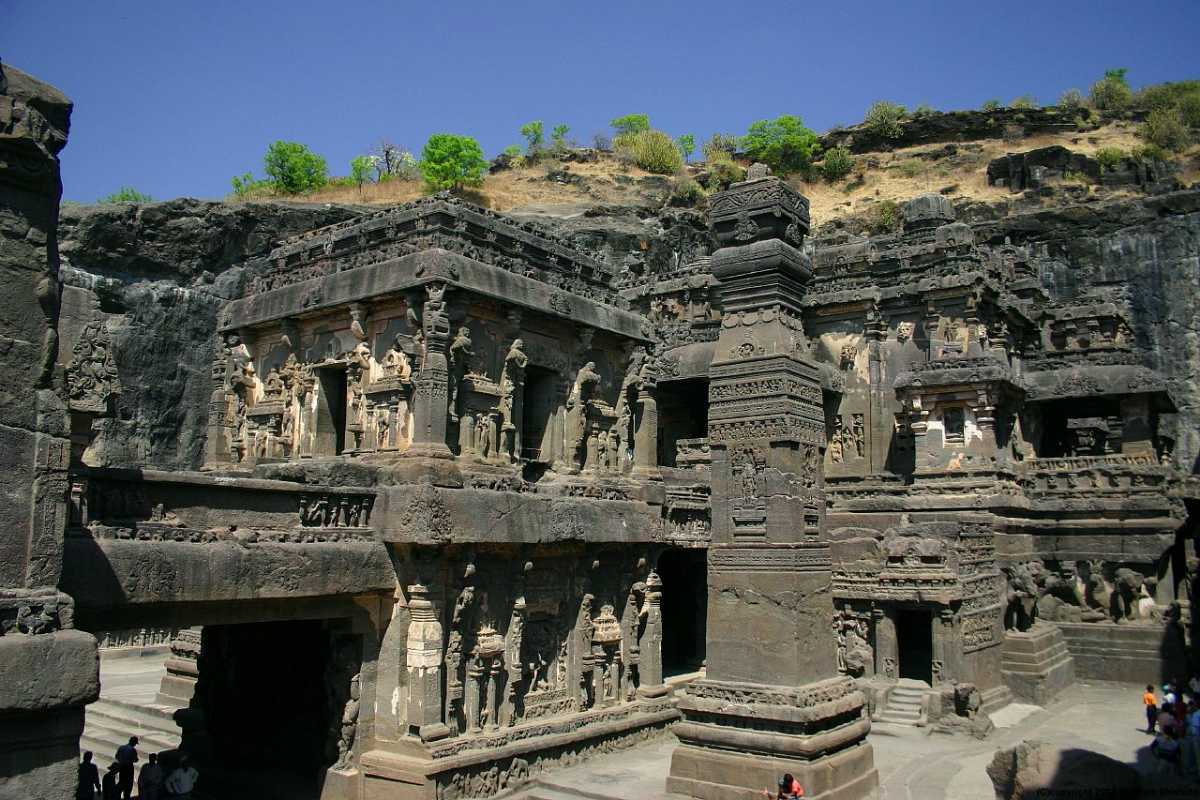
Ajanta and Ellora Caves in Summer (March - June)
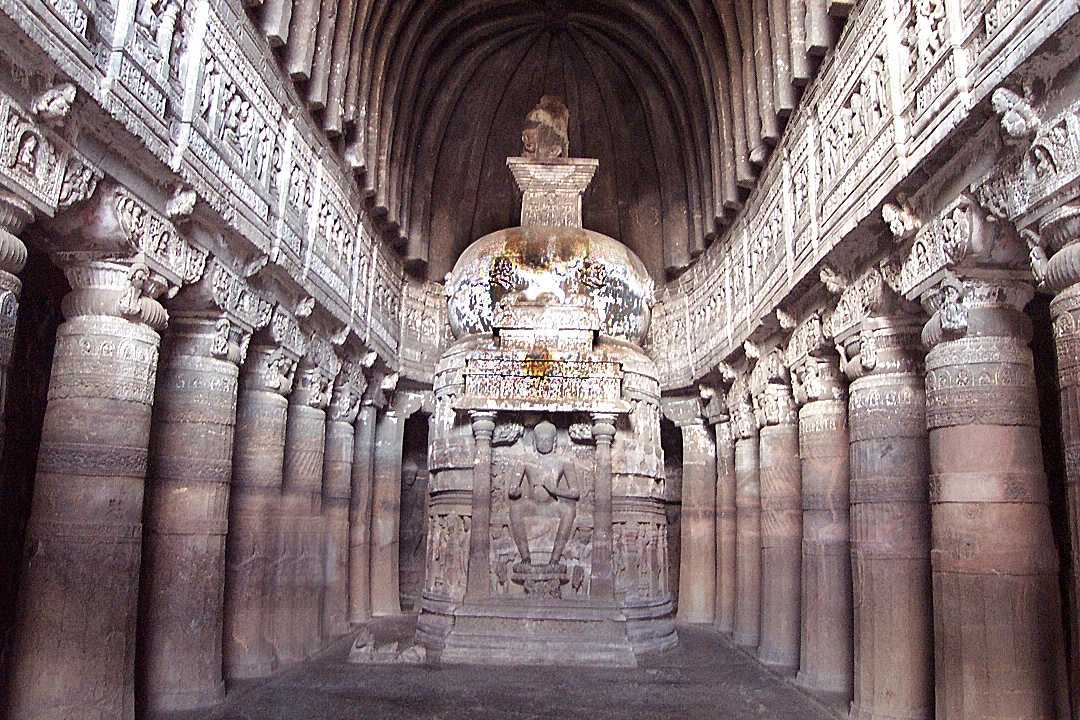
Related Posts

Best Time to Visit Maharashtra
Best Time to Visit India
Nearby Places

Ajanta and Ellora Caves Photos

+ 41 photos
Similar Places

Art & Culture
5 Ajanta Caves Paintings You Need To See

Ajanta Caves History : A Walk Into the Past of Rock-Cut Caves
View All posts about Ajanta and Ellora Caves
Get the best offers on Travel Packages
Compare package quotes from top travel agents
Compare upto 3 quotes for free
- India (+91)
*Final prices will be shared by our partner agents based on your requirements.
Log in to your account
Welcome to holidify.
Forget Password?
Share this page
- Tour Enquiry
- Sign up | Login
- My Bookings
- New User? Sign-up
- Domestic Tours
- South India
- Maharashtra
- Golden Triangle
- North India
- North East India
- International
- Maldives (Discontinued)
- All Domestic Tours
- All International Tours
- Offbeat Tours
- Domestic Cruise Tours
- Jungle Lodges by JLR
- Kabini River Lodge
- Bandipur Safari Lodge
- JLR Kings Sanctuary
- River Tern Lodge
- Kali Adventure Camp
- Hampi Heritage & Wilderness Resort
- K Gudi Wilderness Camp
- Car Rentals
- Destinations
- Tourist Places on Drive
- Driving Directions
- * Workation
- * Tour Plans
- List Property
- Ajanta Caves
- Places to Visit in Ajanta Caves
14 Top Tourist Places to Visit in Ajanta Caves
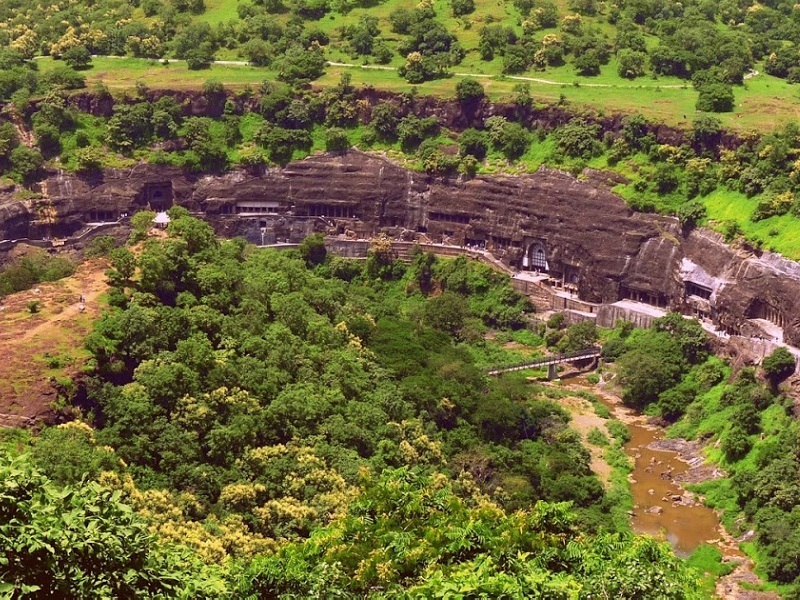
- Ajanta Caves Overview
- Top 14 Places to Visit in Ajanta Caves
- 19 Best Ajanta Caves Tour Packages
- Top Resorts in Ajanta Caves
- Best Time to Visit Ajanta Caves
- How to Reach Ajanta Caves
- Driving Directions to Ajanta Caves
- within 1 km
- within 5 km
- within 10 km
- within 20 km
- within 30 km
- within 40 km
- within 50 km

#1 of 14 Places to Visit in Ajanta Caves
At a distance of 350 m from Ajanta Foot Cave Bus Stop, Cave 1 is an ancient rock-cut cave situated in the cave complex of Ajanta. It is one of the best-preserved caves, and among the most popular places to visit as part of Ajanta Caves tour packages . Cave 1 is situated on the eastern end of the horseshoe-shaped bend of the rock surface and is the first cave the visitor encounters. Cave 1 is considered to be the most splendid Buddhist vihara in India and among the famous places to visit in Ajanta Caves . Possibly created to be an imperial cave of king Harishena, the monastery, consists of a hall sided by 14 cells, vestibule, sanctum sanctorum, an open verandah flanked by a cell on each side, and an open courtyard with two cells on the sides, datable to 4th - 5th centuries AD. There are three doorways: a central doorway and two side doorways. .....
...read more
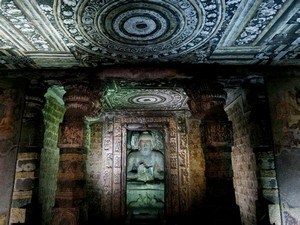
#2 of 14 Places to Visit in Ajanta Caves
At a distance of 400 m from Ajanta Foot Cave Bus Stop, Cave 2 is situated just beside Cave 1 in Ajanta. It is one of the famous and most visited tourist places in Ajanta . Cave 2 is known for the paintings that have been preserved on its walls, ceilings, and pillars. It is one of the must include places in Ajanta tour packages . Its architectural plan is quite similar to the neighbouring Cave 1 and is in a better state of preservation. This cave consists of cells, sanctum sanctorum, and two pillared sub-shrines datable to 6th century AD. The facade of this Mahayana monastery cave shows the kings of Naga and their followers. Cave 2 has a porch quite different from Cave 1. The cave is supported by robust pillars, ornamented with designs. The front porch consists of cells supported by pillared vestibules on both ends. The paintings on the .....
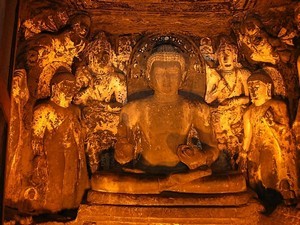
#3 of 14 Places to Visit in Ajanta Caves
At a distance of 450 m from Ajanta Foot Cave Bus Stop, Cave 4 is situated near Cave 2. This is one of the popular and most visited caves in Ajanta. Cave 4 is the largest vihara planned on a grandiose scale but was never finished. An inscription on the pedestal of the Buddha's image inside the shrine mentions that it was a gift from a person named Mathura. This cave consists of a hall, sanctum sanctorum, pillared verandah and is datable to first half of the 6th century AD. The verandah which is supported by eight octagonal pillars with bracket-capitals has a cell at either end. The rear wall of the verandah contains the panel of Litany of Avalokitesvara. The hall has 28 pillars arranged in a square, which are similar to those in the verandah. On the three sides of the hall are hewn a number of cells, many of which can be seen at different stages of excavation. The hall has one main entrance and two side-doors with wide windows in between. Flying figures, guardians, images of .....
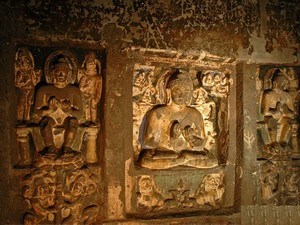
#4 of 14 Places to Visit in Ajanta Caves
At a distance of 650 m from Ajanta Foot Cave Bus Stop, Cave 16 is one of the popular caves situated in the middle of the Ajanta complex. Some of Ajanta's finest paintings can be seen in this cave and is one of the later Vihara caves. Cave 16 is called the Welcome Gate of Ajanta. Two elephants are at the doorway to welcome the visitors. It also contains some renowned paintings like in Cave 1, 2 and 17. According to an inscription found here, the excavation of this cave was caused by Varahadeva, the minister of Vakataka king Harishena (circa AD 475-500). The cave consists of a central hall surrounded by 14 cells on three sides, vestibule and a sanctum for Buddha image. Two elephant statues at the base of stairway lead to the cave. The inner shrine has a giant statue of Buddha seated on a throne in the abhayamudra or teaching gesture. Lions and other active animals support the throne. Bodhisattvas stand behind him. This cave gives a good view of the ravine. The cave chamber .....
Cave 17 & 18
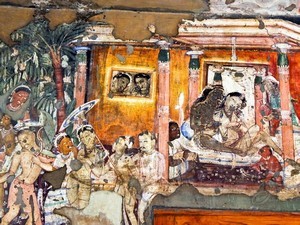
#5 of 14 Places to Visit in Ajanta Caves
At a distance of 700 m from Ajanta Foot Cave Bus Stop, Cave 17 is one of the popular caves in Ajanta and is situated just beside the famous Cave 16. Cave 17 is a Mahayana monastery covered with many well-preserved wall paintings. A Brahmi inscription found here records the excavation of this cave by a feudatory prince under Vakataka king Harishena. This monastery consists of a spacious hall surrounded by 17 cells on three sides, a vestibule and a sanctum containing the image of Buddha. The porch doorway of cave 17 is similar to that of cave 16, with which it is contemporary. The panel above the doorway depicting the seven Manushi Buddhas (Buddhas in human form) together with the Maitreya or future Buddha seated under their respective Bodhi trees. The plan of this cave is simple and severe. The pillars in both the porch and interior are arranged in a strict order. The pillars near the shrine have intricate carvings. The Buddha in the shrine is seated in Dharmachakra mudra, or .....
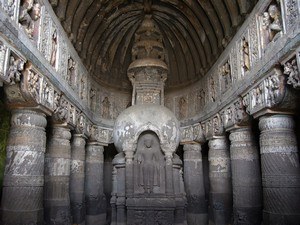
#6 of 14 Places to Visit in Ajanta Caves
At a distance of 710 m from Ajanta Foot Cave Bus Stop, Cave 19 is one of the popular caves in Ajanta and is situated just beside the Cave 18. Cave 19 is a chaityagriha datable to 5th century AD and could be the gandhakuti. The same donor as cave 17, a feudatory prince under Vakataka king Harishena, patronized this cave. This is a small cave but singularly well-proportioned chaityagriha and is one of the most perfect specimens of Buddhist rock-cut architecture at Ajanta. Though separated in date from the earlier chaityagrihas by several centuries, it traditionally maintains the older plan with the only innovations that the image of Buddha is now introduced on the votive stupa. The imitation of wooden beams still persists in the stone ribs of the vaulted ceiling. Of the seventeen interior pillars, thirteen resemble those of Ajanta Cave 1, both in workmanship and design, their capitals having the seated figures of Buddha at the center and the projecting brackets being occupied .....
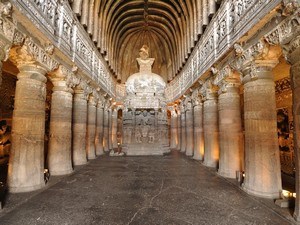
#7 of 14 Places to Visit in Ajanta Caves
At a distance of 750 m from Ajanta Foot Cave Bus Stop, Cave 26 is a chaityagriha situated beside the Cave 25. This cave belongs to Mahayana school of Buddhism and is one of the most popular caves to be visited in Ajanta. Cave 26 is quite similar to Cave 19, but of a larger dimension and with more elaborately and exquisitely carved sculpted figures. An inscription (AD 450 - 525) found on the wall of the front verandah records the gift of this chaityagriha by a monk Buddhabhadra, a friend of Bhavviraja, a minister of the king of Asmaka (Vidarbha). The chaityagriha consists of a hall, side aisles (pradakshina) and a rock-cut stupa with an image of Buddha. The facade, inner pillars, triforium (between pillars and roof), and side walls are extensively carved with images and decorative designs. The cave contains a stupa with an image of Buddha seated on a lion throne. He is flanked by riders and flying attendants. However, the most striking and prominent image of this cave .....
Cave 5 To 8

#8 of 14 Places to Visit in Ajanta Caves
At a distance of 450 m from Ajanta Foot Cave Bus Stop, Cave 5 to 8 are situated beside Cave 4 at Ajanta in Aurangabad district of Maharashtra. Cave 5 is an unfinished vihara in Ajanta group of Caves. The richly-carved doorway and the female figures standing on makaras are the main attractions of this cave. The design of frescoes are intricately done and portrays are some of the best designs in Ajanta. Cave 6 is a double storeyed vihara consisting of a hall, sanctum sanctorum and a pillared hall in the lower storey and a hall with cells, subsidiary cells and sanctum sanctorum in the upper storey. Buddha in preaching attitude is housed in both the shrines. The depiction of Miracle of Sravasti and Temptation of Mara are the important paintings in the lower storey. The upper floor of Cave 6 has many private votive sculptures, and an unfinished Buddha Shrine. Besides the main shrine, there are two more chapels containing images of Buddha. The cave has a profusion of carved figures .....
Cave 9 To 11
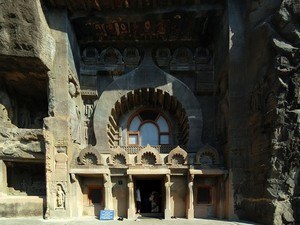
#9 of 14 Places to Visit in Ajanta Caves
At a distance of 550 m from Ajanta Foot Cave Bus Stop, Cave 9 to Cave 11 are situated beside Cave 8 at Ajanta in Aurangabad district of Maharashtra. Cave 9 is an apsidal chaityagriha datable to 2nd century BC and belongs to the Hinayana phase of Buddhism. The chaityagriha consists of an entrance door, two side windows, central hall, nave flanked by side aisles (pradakshina) on either side separated by a row of 23 pillars and a stupa, the object of worship. The chaityagriha exhibits reproduction of wooden architectural styles, in the form of inward tapering octagonal pillars, evidence of fixing wooden beams & rafters, etc. The chaitya was in use during later period also as indicated by the sculptures of Buddha on the facade and side walls facing the court. The cave consists of two layers of paintings, the earlier dating back to the second half of 1st century BC and the later to 5th - 6th centuries AD. Cave 10 is also a chaityagriha datable to 2nd century BC and belongs .....
Cave 12 To 15
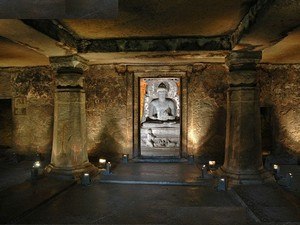
#10 of 14 Places to Visit in Ajanta Caves
At a distance of 600 m from Ajanta Foot Cave Bus Stop, Cave 12 is situated adjacent to Cave 11 at Ajanta in Aurangabad district of Maharashtra. Cave 12 is a Hinayana vihara which was excavated in the 2nd century BC and it is probably one of the earliest excavations at Ajanta. The facade has collapsed and reveals the plain interior square hall. It has 12 cells and each cell having two stone-beds. The skillfully carved sleeping berths in the cells. An inscription on the back wall of the monastery records the gift of this cave by one merchant Ghanamadada and paleographically datable to 2nd - 1st century BC perhaps slightly later than Cave 10. The walls of the hall above the cell-doors are ornamented with chaitya-window motifs. Cave 13 is an incomplete vihara belongs to Hinayana phase of Buddhism. This is a small monastery and consists of an astylar hall with seven cells on three sides. The cells are provided with rock-cut beds. Cave 14 is an unfinished monastery and was .....
Cave 20 To 25
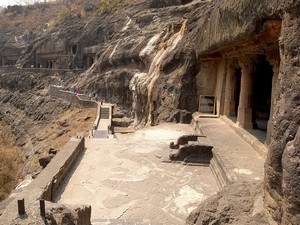
#11 of 14 Places to Visit in Ajanta Caves
At a distance of 750 m from Ajanta Foot Cave Bus Stop, Cave 20 is situated just beside the Cave 19. Caves 20 to Cave 15 are unfinished viharas and less popular than other caves at Ajanta . Cave 20 is a pillar less vihara consists of hall, cells, sanctum sanctorum and a pillared verandah datable between 450 AD and 525 AD. A Brahmi inscription in the verandah records the gift of the mandapa by one Upendra. Buddha in preaching attitude is housed in the sanctum. The sculpture of seven Buddhas accompanied by attendants is another important sculptural panel in this cave. Cave 21 is also a vihara and is the first cave behind periodic waterfall. This cave consists of a hall with 12 pillars, 12 cells, a sanctum sanctorum, and a pillared verandah. Out of 12 cells four are with pillared porches. The sanctum houses a seated Buddha in preaching attitude. The pillars are well carved and the remains of plaster show that there were paintings .....
Cave 27 To 29

#12 of 14 Places to Visit in Ajanta Caves
At a distance of 770 m from Ajanta Foot Cave Bus Stop, Cave 27 is a vihara situated beside the famous Cave 26. Cave 27 is could have been part of Cave 26 and it consists of two storeys, the upper one partially collapsed. The monastery consists of a hall with four cells, antechamber and sanctum sanctorum. Buddha in teaching attitude is housed inside the sanctum. There is a Naga dwarpala on the outer flank of the shrine. The porched doorway of Cave 27 is derived from the shrine doorway of Cave 2. Cave 28 is an unfinished monastery of which only the pillared verandah was excavated. Cave 29 is an unfinished chaityagriha in its first stage of excavation and located at the highest level, located between Caves 20 and 21. Here starts a waterfall of Waghur River with seven cascades (sat-kund). Timings: 9 AM to 5 PM on all days except Mondays.
Ellora Caves
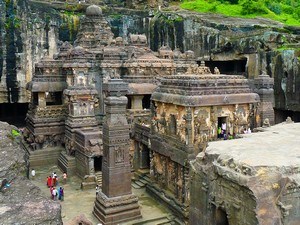
#13 of 14 Places to Visit in Ajanta Caves
At a distance of 28 km from Aurangabad, 98 km from Ajanta Caves, 104 km from Shirdi, 176 km from Nashik, 253 km from Pune, and 344 km from Mumbai, Ellora Caves are ancient historical caves located at Verul near Aurangabad in Maharashtra. Ellora is the most visited monuments of heritage in India , and among the top tourist places in Maharashtra . Locally known as 'Verul Leni', these caves are were designated a UNESCO World Heritage Site in 1983. Ellora is one of the top places to visit near Aurangabad . The caves at Ellora were carved out of the vertical face of the Charanandri hills between the 6th and 10th centuries AD. The carving work began around 550 AD, about the same time the Ajanta Caves were abandoned. Kailash Temple (Cave16), which is the most remarkable structure ..... Distance (From Ajanta Caves Bus Stop): 98 Kms Trip Duration (From Ajanta Caves Bus Stop - Including Travel): Full Day .....
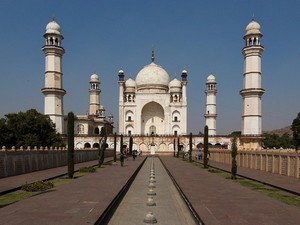
#14 of 14 Places to Visit in Ajanta Caves
At a distance of 108 km from Shirdi, 181 km from Nashik, 232 km from Pune, 350 km from Mumbai, 482 km from Nagpur, and 534 km from Hyderabad, Aurangabad is a historical city and the administrative headquarters of the Aurangabad Division or Marathwada region in Maharashtra. In 2010, the Maharashtra Tourism Minister declared Aurangabad to be the tourism capital of Maharashtra. It is one of the top places to visit as part of Maharashtra tour packages . Popularly known as the City of Gates, Aurangabad is among the prominent historical places to visit near Pune . The city was founded in 1610 AD by Malik Ambar, the Prime Minister of Murtaza Nizam Shah of Ahmadnagar and his son Fateh Khan changed the original name Khadki to Fatehnagar. The areas around Aurangabad were under the control of Delhi Sultanates, Bahamani Sultans, Nizam Shahis, Mughals, and Hyderabad Nizams. With the capture ..... Distance (From Ajanta Caves Bus Stop): 98 Kms Trip Duration (From Ajanta Caves Bus Stop - Including Travel): 1-2 Days .....
Most Asked Questions on Ajanta Caves
Post Monsoon and Winter are the best seasons to visit Ajanta Caves . This is also the best time to explore western ghats in lush greenery with waters flowing from various streams are at their full glory. Winter is the busiest season in Ajanta Caves and hotel prices are also very high during this season.
Ajanta Caves usually takes full day to visit the most important places. Several tourists usually prefer visiting Ajant Caves along with Ellora Caves which requires an additional day. Ajanta Caves can be mixed with near by wonderful destination like Aurangabad, Shirdi and Nashik by adding few additional days to your trip.
Budget of Ajanta Caves trip depends on the trip duration and category of hotel you choose for your stay along with the kind of vehicle you prefer. Ajanta Caves tour packages offered by Trawell.in start from as low as INR 6850 per person for a 2D/1N trip and from INR 8700 per person for 3D/2N vacation.
Yes, one must hire a guide to explore the ancient caves and its historical beauty of Ajanta. A guide can only explain to you the true life details of Lord Buddha�s life, before he attained moksh (salvation) that inscribed on the walls of Ajanta Caves.
Normally, it takes 6-7 hours to see all the caves in Ajanta.
Top 5 Ajanta Caves Packages
Ajanta caves blogs, ajanta caves related packages, ajanta caves related pages.
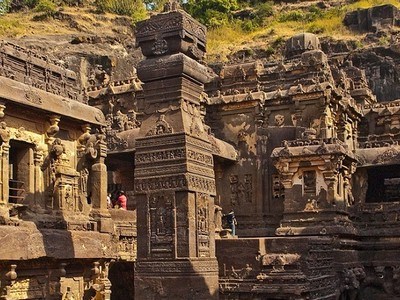
Places to Visit in Popular Sites in India
- Coorg Tourist Places
- Ooty Tourist Places
- Munnar Tourist Places
- Shimla Tourist Places
- Mahabaleshwar Tourist Places
- Chikmagalur Tourist Places
- Wayanad Tourist Places
- Pondicherry Tourist Places
- Goa Tourist Places
- Andaman Tourist Places
- Hampi Tourist Places
- Ajanta Ellora Tourist Places
- Lonavala Tourist Places
- Nainital Tourist Places
- Agra Tourist Places
- Jaipur Tourist Places
- Kodaikanal Tourist Places
- Darjeeling Tourist Places
- Ratnagiri Tourist Places
- Murudeshwar Tourist Places
- Varanasi Tourist Places
- Ayodhya Tourist Places
- Madurai Tourist Places
- Rameswaram Tourist Places
- Shirdi Tourist Places
- Dwarka Tourist Places
- Somnath Tourist Places
- Yercaud Tourist Places
- Dandeli Tourist Places
- Thekkady Tourist Places
- Mussoorie Tourist Places
- Kerala Tourist Places
- Tamilnadu Tourist Places
- Karnataka Tourist Places
- Maharashtra Tourist Places
- Orissa Tourist Places
- Sikkim Tourist Places
- Kashmir Tourist Places
Near By Places

Similar Places
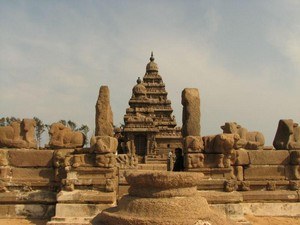
100% SECURE PAYMENTS
Domestic & International Cards Accepted

Our WhatsApp Numbers
Kerala, Tamilnadu, AP & TG Tours
Karnataka Tours
Goa, Maharashtra, Gujarat Tours
North India Tours
Rest of India
International Tours
Request Quote
Travellers #
Explore Tour Packages
Discover Affordable Tour Packages
Need Customized Tour? Request Quote
Login / sign-up.
Your Sign in was successful! Itinerary will be downloaded shortly.
Sign up with Trawell.in
Already Created Account? Login Here
Sign in with Trawell.in Account
Forgot Password?
New User? Sign Up Here
Activate Your Trawell.in Account
Your account is activated successfully. Login Here
Reset Your Trawell.in Password
Your password has been reset successfully. Login Here
Booking Policy
Weekend backpacking to Ajanta Ellora Caves #TravelIndia

#While studying Indian history during school days, Ajanta and Ellora Caves were one of the famous topics. Ajanta Caves date back to 2nd century. These Buddhist cave monuments were discovered by an Army Officer of the British Army on one of his hunting expeditions. It became a world famous finest example of Indian art, specifically painting.
We took a train to Jalgaon station from Mumbai. Early in the morning had a mixed poha-sev breakfast outside the station. Took a direct bus from there. We decided to visit the Ajanta Caves on the 1st day since it was near to Jalgaon. Photography is allowed inside the caves but without flash, to preserve the paintings. Most of the caves need to be visited barefoot so wear a shoe/sandal accordingly. The whole range of the Caves is of a horse shoe shaped.
Needless to say, it was not easy to believe that such kind of master Art could be made by human beings with natural colours inside rock mountains in the forests.
There is also a narrow stream of water known as Waghora. There are people selling the original raw gemstones and corals that they cut themselves from deep inside the nearby hills. From there it is exported to the other parts of the country.
The paintings speak tell the stories from our Indian history. It’s mesmerizing to see such great Art so many centuries ago. There is a vast rock cut statue of sleeping Gautam Buddha.
On the 2nd day we started for Ellora Caves. Took a public bus and got down at the gates of Ellora. There were few langurs in the lawn to welcome us :P
On entering the premises, the gigantic impeccable example of Indian architecture is seen in the form of the Great Kailash Temple. It is a single rock mountain cut from the top to bottom to create this epic temple.
The entire Mahabharata is depicted through the sculptures in the rocks. The giant Shiv Linga which is also a single rock cut.
The Ajanta Caves are a beautiful example of our ancient paintings whereas the Ellora Caves for the majestic rock sculptures.
While returning we covered Bibi ka Maqbara and Daulatabad Fort.
A weekend well spent and covered few of the most spectacular sites near Aurangabad :)
Ajanta Caves
A partial view of the Ajanta Caves
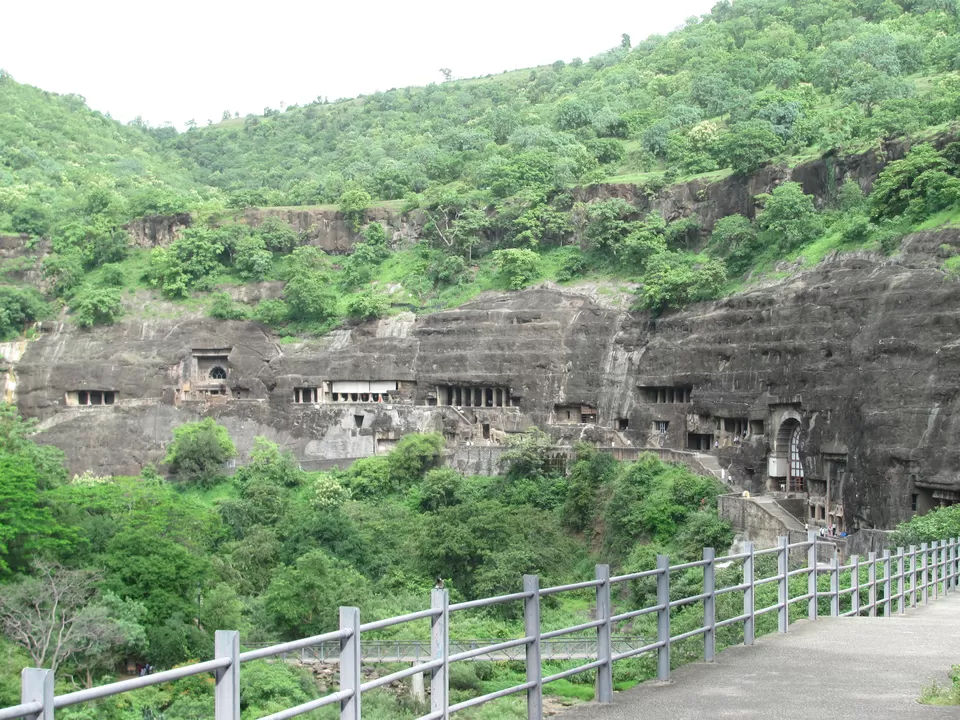
Devagiri Daulatabad Fort
Canon at Daulatabad Fort
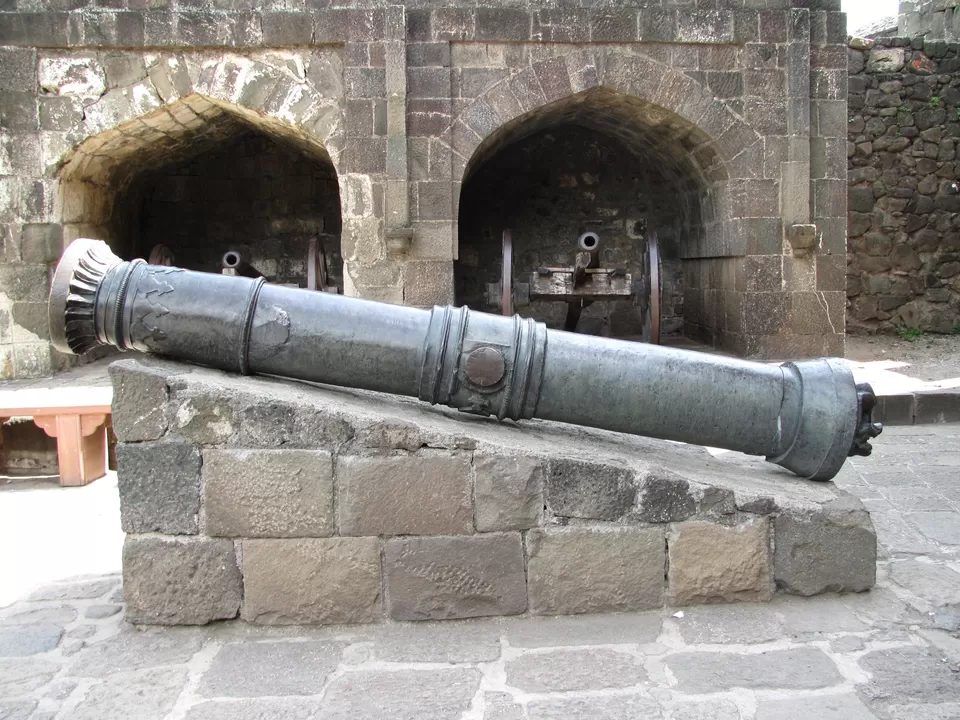
Took a train from Mumbai to Jalgaon
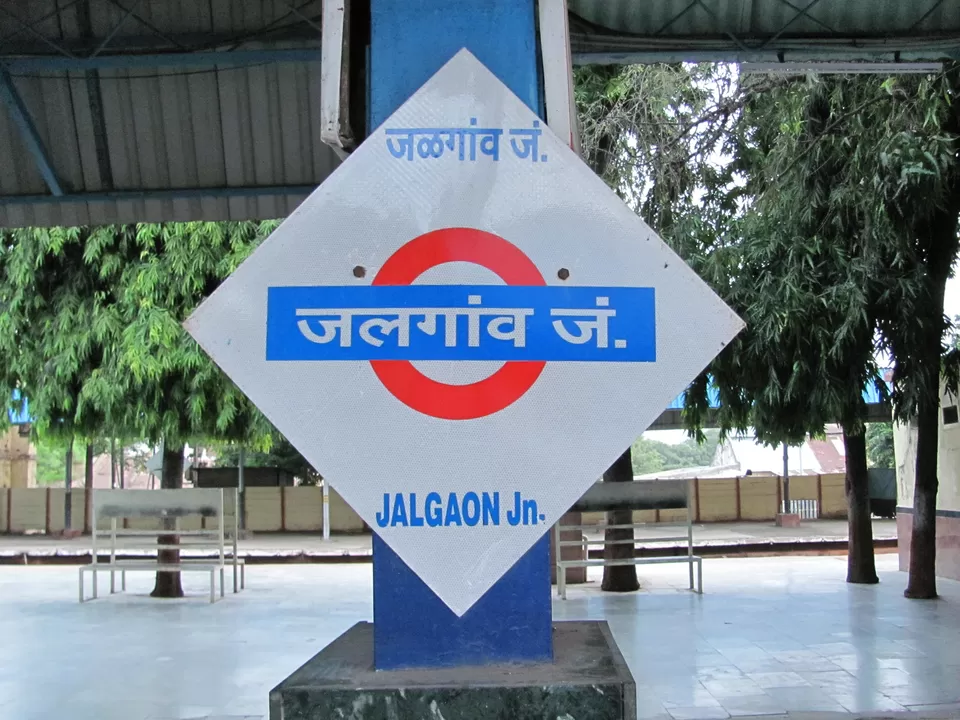
Maharashtra Packages

Further Reads
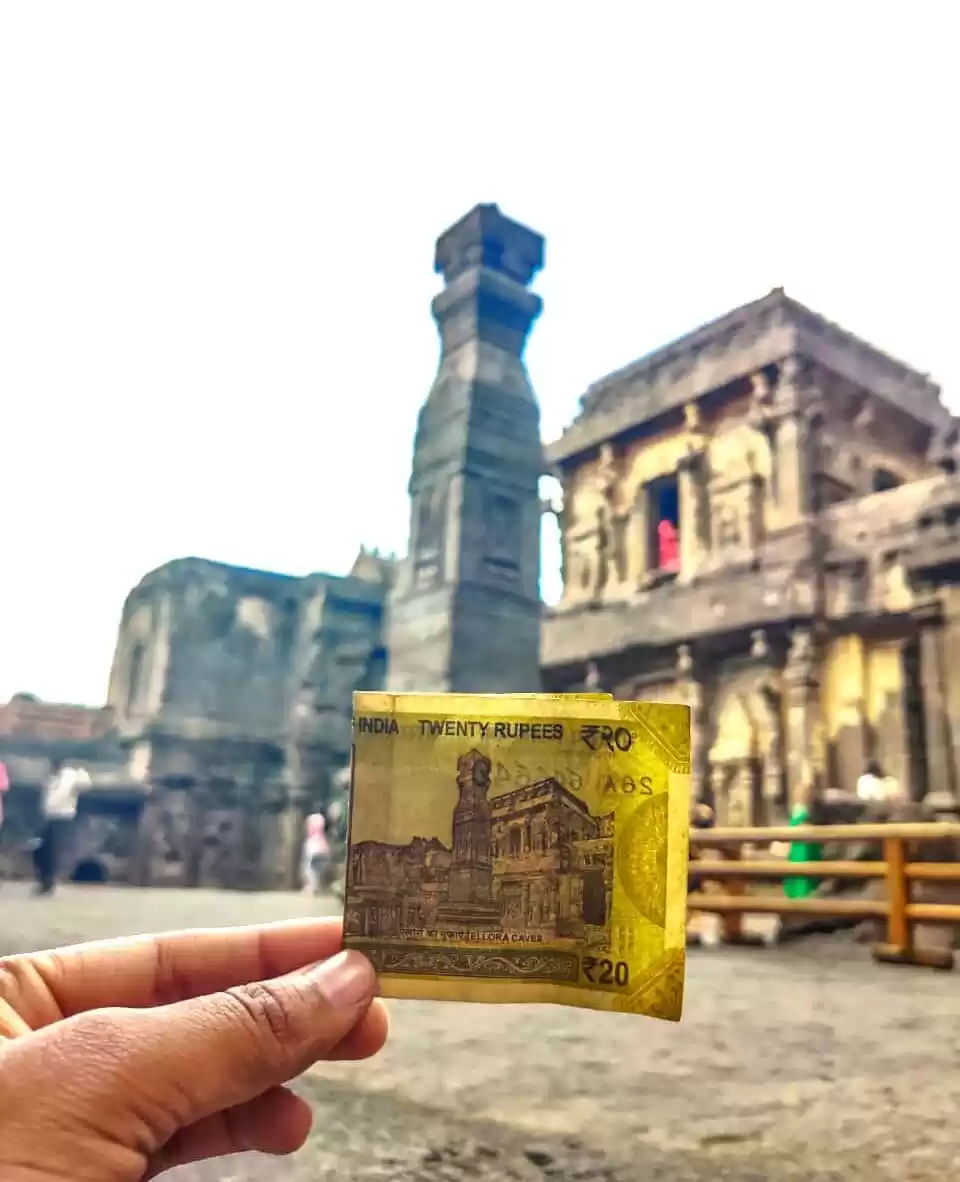
Living the Life My Mom Warned me About
How to See Ajanta and Ellora Caves on Your Own | Itinerary with Costs

This has been my dream for the longest time, and it was quite shameful that despite having stayed just hours away from these two iconic world heritage sites, I hadn’t visited them. In any case, 2023 was my year to visit all Maharashtra’s UNESCO sites such as this and this . Therefore, on my birthday weekend, I decided to gift myself a trip: a visit to the world-famous Ajanta and Ellora Caves . Aurangabad in Maharashtra, India, served as the home base for this trip.
Here is how you can do it on your own, comfortably, and for cheap. Read on.
Aurangabad is a city on the Deccan Plateau in west-central India, in the state of Maharashtra. It was built by the Mughal emperor Aurangzeb in 1610, and it became the main city of the Mughals in the Deccan until their empire fell apart in the 1700s. The city, located on the banks of the Kham River , is a major tourist destination today. It is known for historical monuments such as the Bibi Ka Maqbara, the Daulatabad Fort, and, most importantly, the UNESCO World Heritage Sites of Ajanta and Ellora Caves .
Aurangabad has a hot and dry climate, with summer temperatures hovering at 40°C and winter temperatures at 20°C. Thus, November to February is a good time to visit.
How to reach
Aurangabad is in the western state of Maharashtra, India, and can be reached via train or a 55-minute flight from Mumbai, the capital of Maharashtra. Janshatabdi is the fastest train from Mumbai. It takes about 6 hours from Chhatrapati Shivaji Maharaj Terminus (CSMT), to arrive at Aurangabad Station (AWB). After reaching Aurangabad, you can hire a private car (more on this later) or use State Transport buses departing from the Aurangabad Central Bus Stand (CBS) every few hours to reach the caves. MTDC also runs tours although I didn’t see any signs of them on my visit. Now diving into the most interesting part – about the Ajanta and Ellora caves…
Ajanta Caves
The Ajanta Caves are a collection of 30 rock-cut Buddhist cave monuments dating back to the 2nd and 1st centuries B.C. and enhanced further during the Gupta period (5th and 6th centuries A.D.). These caves are known for their exquisite murals depicting Buddhist tales, fables, and mythological scenes . The caves were accidentally discovered in 1819 by a British cavalry officer while he was out hunting tigers. The caves were carved out of the vertical cliff face along the Waghora River . Found in a state of disrepair, the Ajanta Caves have been painstakingly restored, today drawing visitors from around the globe as a UNESCO World Heritage Site.

Ellora Caves
The Ellora Caves, a UNESCO World Heritage Site, were carved out of the basaltic Charanandri Hills between the 6th and 10th centuries CE. The caves are spread over two kilometres along the escarpment of the Charanandri Hills and are divided into three distinct groups: Buddhist (caves 1–12), Hindu (caves 13–29), and Jain (caves 30–34). The Hindu caves are renowned for their intricate sculptures and carvings. For example, Cave 16, the Kailasha temple, is a marvel of rock-cut architecture, showcasing a monolithic temple complex carved out of a single basalt rock . The Buddhist caves are characterized by their serene atmosphere, with carvings and murals depicting the life of Buddha and Buddhist teachings. The Jain caves, the most recent addition to the Ellora complex, showcase the Jain concept of non-violence and asceticism, often featuring intricate carvings of Jain deities and Tirthankaras.
Ellora was also accidentally discovered in the 18th century by British officers. That makes one wonder how many more such wonders are tucked away, waiting to be found. Also, makes one wonder about the thought process that triggered the creation of these cave sites in the first place. They must have taken centuries to plan, build, carve, and enrich. All for meditation and prayer. Lastly, I also wonder, have we built anything that will stand the test of time and fill future generations with such awe?
How are Ajanta and Ellora different?
- Ajanta Caves are known largely for their paintings, while the Ellora Caves mostly house sculptures.
- Ajanta Caves are all Buddhist, while Ellora Caves comprise Hindu, Buddhist, and Jain sculptures.
- Ajanta Caves are farther away from the city of Aurangabad.
- The Ajanta Caves, due to their earlier construction and the use of natural pigments, have faced greater degradation over time. The Ellora Caves are in a much better state.
- In my view, if you are pressed for time, the Ellora Caves are the better choice to visit. They are easier to get to, are much better preserved because they are largely comprised of sculptures, and are incredibly impressive. However, for the same reason, the complex draws massive crowds. I found Ajanta more peaceful and fun to visit.
Other Notable Sites in Aurangabad District
Apart from Ajanta and Ellora Caves, here are some of the other must-see sites in and around Aurangabad:
- Grushneshwar Jyotirlinga Mandir is one of the 12 Jyotirlinga temples, and the last one, and is considered an auspicious place to visit by the Hindus. The temple is a national protected site and close to the Ellora Caves.
- The Daulatabad Fort is a historic fortified citadel located in Daulatabad village 20 km from Aurangabad. It was the capital of the Yadavas (9th century – 14th century CE) and, for a brief time the capital of the Delhi Sultanate (1327 – 1334).
- The Bibi Ka Maqbara is a beautiful 17th-century mausoleum commissioned by Aurangzeb’s son Azam Shah in memory of his mother Dilras Banu Begum. It is also known as mini-Tajmahal, well, because it is a slimmer version of it.
- Panchakki is a water mill complex in Aurangabad. It displays medieval Indian ingenuity with a system designed to generate energy via water brought down from a spring on a mountain.
- The Aurangabad Museum houses a collection of artefacts from the region’s history.
- The Aurangzeb Tomb is located in the city of Khuldabad 24 kilometres from Aurangabad. Unlike other Mughal emperors, Aurangzeb’s final resting place is modest.

The Ajanta Caves are located about 105 kilometres (65 miles) from Aurangabad, India. The drive from Aurangabad to the Ajanta Caves takes about 2 hours and 30 minutes. The site is open from 9 AM to 5:30 PM and is closed on Mondays. It requires about 3 hours to explore. Tickets for Indians: INR 40. Tickets for foreigners: INR 600. You can buy tickets on the ASI website . However, on non-peak days, the queues are short and manageable, and you can buy onsite.
My tips for visiting Ajanta Caves
- Overall : There are 30 caves, some of them unfinished and negligible. 16 contain mural paintings, but the best work is found in caves 1, 2, 16, 17, and 19. The best sculptures are in caves, one for 17, 19, 24, and 26. Do not miss these. Five of the caves 9, 10, 19, 26, and 29 are Chaityas, while, the others are Viharas . The central theme on the walls comes under two heads: narrative scenes from Buddha’s life and illustrations of Jataka Tales. Caves 1, 2, 9, 10, 16, and 26 were my favourites , but the smaller ones were quieter, and more atmospheric, offering a sense of peace, and perfect for the introvert.
- When to start: The Ajanta caves open at 9 AM and close at 5:30 PM. Start early from Aurangabad, at 6:30 or 7 AM, to beat the crowds. I arrived at 9:30 AM and had the luxury of exploring many caves in solitude.
- The Viewpoint: Get dropped off at the “Viewpoint” for breathtaking views of the caves (ask your driver). The Viewpoint is located a few kilometres before the official entrance of the caves, so starting from here saves you time. It also saves you from what happens at the actual entrance—waiting for the government bus that takes tourists from the parking lot to the caves (bus fare: INR 25 p.p.); the buses only ply when they fill up and can get crowded. This is what I did and it worked out perfectly. I came down the Viewpoint and reached cave 8 (which has the second ticket counter) at 9:30 AM and moved to cave 26, finding myself on my own in many of the caves. The walk down from the Viewpoint is easy in good weather but can be slippery during monsoon season. Locals around that point will offer to guide you but it’s not necessary. I did buy a guidebook from one of them which came in handy later. Expect your car driver to charge extra for reaching the Viewpoint.
- Guides and Guards: You cannot hire guides if you start from the Viewpoint, but overall, I didn’t think it was required. Cave inscriptions and the guard at each cave will happily answer questions you have. Tipping guards 50-100 rupees is much cheaper than official guides charging 1800 rupees, and since I was travelling solo, it didn’t make much sense to me. Also, I could enjoy at my own pace without feeling rushed.
- Peak Season and Timing: Avoid peak months (December 20th to January end) and peak hours (11 AM to 3 PM, weekends) for a less crowded experience.
- Navigation and Amenities: A leisurely walk through all caves takes about 2.5-3 hours . Water dispensers and toilets are available at regular intervals. Wear flip-flops or easy-to-remove footwear for cave entry. Set your camera to low-light mode for better photography, although photos cannot capture the true beauty of the place. Hawkers and locals will try to sell you things; be polite but firm.

A visit to Ajanta Caves was a truly remarkable experience. While some of the paintings have degraded beyond recognition, their beauty as what-once-was is undeliable. The caves transported me back 2,000 years, offering a glimpse into the lives of Buddhist monks who once prayed, lived, and meditated inside their confines. It was a Buddha Idol overload for sure, but you cannot but help marvel at the sheer artistry and grandeur of that era. I was reluctant to leave and truly enjoyed my time at Ajanta.
The Ellora Caves are located about 29 kilometres (18 miles) northwest of Aurangabad, India. The drive from Aurangabad to the Ellora Caves takes 30-45 minutes depending on the time of day. The ticket price is INR 25 for Indian nationals and INR 300 for foreigners. The caves are open from sunrise to sunset each day. A trip to Ellora Caves is usually clubbed with a city tour.
The Ellora Caves consist of 12 Buddhist caves (1–12), 17 Hindu caves (13–29), and 5 Jain caves (30–34) .

My tips for visiting Ellora Caves
- Ellora gets super crowded , much more than Ajanta. Be sure to reach as soon as the caves open at sunrise, and avoid weekends if possible. Buy a ticket online ( ASI website ) in case the ticket counter is not open that early.
- As soon as you enter, finish Cave 16, i.e. the Kailasha Temple . I got the edifice all to myself and I had the best time ever. The only bummer? There was no one around to take my pictures as I was solo. But if you go to Cave 16 later in the day, you will realize what a privilege and experience it was to enjoy it alone. Cave 16 is stunning beyond belief. My jaw was on the floor the whole time.
- Finish Cave 16 and then walk to Cave 1 to do the Buddhist and Hindu caves in order and return to the starting point at Cave 16
- Next, from Cave 16 take the golf cart to Cave 30 (and see the Jain Caves 30 through 34) and then go to 29 using the cart and walk back to 16 (or take the cart). Cave 29 (Dumar Lena) is another massive, impressive Hindu cave
- Keep the receipt of the golf cart because it is checked during return
- My favourite Ellora Caves were 16 (Kailasha, the largest monolithic temple), 10 (Vishwakarma), Cave 21 (Ramesvara), and 12 (Teen Tal). Cave 15 (Dasavatara) was super impressive with the Dashavatara but it needed serious lighting to enjoy. Cave 30 was an impressive Jain Cave. Not to be missed.
- Ellora has more massive sculptures than Ellora but they are not well lit . Thus, photography is harder.
- Ravana shaking the Kailasha mountain is a popular theme in Ellora. Try to catch it in every cave.
- There is no need to remove slippers in a majority of the caves except for the sanctum of Kailasha Temple

The Kailasha temple of Ellora is a megalith carved from a rock cliff face. It is considered the most remarkable cave temple in the world because of its size, architecture and sculptural treatment and “the climax of the rock-cut phase of Indian architecture”. It’s gorgeous beyond imagination.
Seeing Both Together
The best way to do Ajanta and Ellora caves is to do it leisurely over two days. I stayed at Hotel Green Olive, which provided me with a driver and car. A trip to Ellora and city sightseeing cost me INR 1700, and a trip to Ajanta cost me INR 2800. They also arranged for airport pick-up and drop-off for INR 400. Pretty cost-effective. Contact their travel Agent (Zafar: +91 97644 07200)
I briefly considered a package from Tour My Choice which quoted INR 6,500 for a car and driver hire over two days. They also had a one-day Ajanta and Ellora package, starting at 7 a.m. and ending at 6 p.m., and costing INR 4,800 for the car and driver hire. But I guessed this whirlwind of a tour might not do justice to the beauty and grandeur of the marvellous UNESCO World Heritage Sites.
Tour guides to see the caves can be obtained on-site. One cannot pre-book a guide. The guides are allocated based on a queue.
Maharashtra Tourism Development Corporation, i.e., MTDC, also runs tours although I didn’t see any evidence of it.
Note that the Ajanta Caves are closed on Monday, and the Ellora Caves are closed on Tuesday.
Three Other Places to Visit
Grishneshwar temple.
Not far from Ellora Caves, lies Grishneshwar Temple, a sacred Hindu temple dedicated to Lord Shiva. It’s not just any temple, though. It’s one of the holiest pilgrimage sites for Hindus, and for a special reason: it houses the 12th and last Jyotirlinga on earth. It was Sunday when I went and the rush was mad so I skipped the trip inside, but it may be of interest to devotees or those who want to sample what crazy devotion looks like.

Daulatabad Fort
Close to Ellora is also Daulatabad Fort.
Daulatabad Fort, a historic fortified citadel located in Daulatabad village near Aurangabad, is more about the legends than the place itself. It is a long, arduous hike to the top even in December but more interesting are the points in between. For example, Chini Mahal , where the last Qutb Shahi ruler was imprisoned until he died, or Chand Minar , a replica of the Qutb Minar of Delhi, made of Lapis Lazuli & Red Ocher, now shut due to suicide, and more interestingly (and tragically) the story of Muhammad bin Tughluq, who in a moment of folly, relocated the entire Delhi population to Daulatabad (formerly Devagiri). When he realized his mistake, he reversed his decision, forcing everyone back to Delhi, resulting in the death of nearly half the population. Occupied since at least 100 BC, the site served as the Yadava capital from the 9th to the 14th century before briefly becoming the Delhi Sultanate’s capital. Inside the fort, the main attraction is not the structure itself but rather the various cannons strategically placed at different levels, serving as a reward for the challenging climb. The top offers a good view of the city. As I was travelling alone, I faced some staring and mild heckling. A lot many young men make the hike. I didn’t see any foreigners.

Bibi Ka Maqbara
Taj Mahal, it is not, but it ain’t bad either. Bibi Ka Maqbara, located in Aurangabad, is a mausoleum commissioned and built by Prince Azam Shah in memory of his mother, Dilras Banu Begum, wife of Aurangzeb. Bibi Ka Maqbara is often referred to as the “Mini Taj” due to its resemblance to the Taj Mahal, built by Shah Jahan in honour of his wife, Mumtaz Mahal. Bibi Ka Maqbara features gorgeous white marble inlay work, intricate floral designs, and four minarets flanking the central dome. The day I visited, the place was teeming with schoolchildren. Never visit Indian heritage monuments on a Sunday after 11 AM.
Where to Stay
There are a couple of good hotels next to each other. They are:
Budget : 7 Apple Hotel (next to DMart), Click Hotel , Hotel Green Olive (Where I stayed)
Moderate : Lemon Tree , Fern Residency , Enrise by Sayaji
Luxury : Vivanta , Welcomhotel By ITC Hotels
Total Trip Cost
- The flight from Mumbai to Aurangabad (return) cost INR 8,000 (Indigo)
- The 3-night hotel stay cost INR 10,000 at Hotel Green Olive (including breakfast)
- Two-day car and driver hire: INR 4500 (Alternately, you go in local buses)
- Airport pick-up and drop: INR 800 (INR 400 one-way) Uber charges less.
- Meals: INR 2500
- Entry fees: INR 200
- (Optional) Guides at Ajanta and Ellora: INR 1800 * 2
- Total = about INR 26,000

ASI Notes of the Sites
Source: Archaeological Survey of India, Aurangabad Circle
Ajanta Caves (75° 40′ E:20°30’M) are famous for their murals which are among the first surviving examples of Indian art, particularly painting. These caves were excavated horse-shoe-shaped bend of rock scarp nearly 76 mt. in height overlooking a stream known as Waghpra. The location of this valley provided a calm and serene environment for the Buddhist monks who retreated to these secluded places during the rainy season. Each cave was connected to the stream by a flight of steps, which are now almost obliterated, albeit traces of some could be noticed in some places. In all 30 caves were hewn out of the living rock in different periods according to the necessity.
Out of these, five (cave no. 9, 10, 19, 26 and 29) are Chaityagrihas and the rest are viharas. In date and style also these caves can be divided into two broad groups. Out of the 30 caves, 6 caves belong to the earliest phase of Buddhism i.e. Hinayana. Caves 9 and 10 which are Chaityagrihas and 8, 12, 13 and 15A which are Viharas belong to this phase. These caves are datable to the pre-Christion era, the earliest among them being Cave 10 dating from the second century B.C where the object of worship is a stupa. These caves are imitations of contemporary wooden constructions even to the extent of fixing wooden rafters and beams to the ceiling even though they are non-functional.
These early caves were painted but nothing substantial has survived, Caves No.9 and 10 clearly show some vestiges of painting. The headgear, and ornaments of the images in these paintings resemble the bas-relief sculptures of Sanchi and Bharhut. The addition of new caves could be noticed again during the period of Vakatakas, the contemporaries of the imperial Guptas. These were caused to be excavated by the royal family and also the feudatories owing allegiance to the Vakatakas. Varahadeva, the minister of Vakataka king Harishena (475-500 A.D.) dedicated Cave 16 to the Buddhist Sangha while Cave 17 was the gift of a prince (who subjugated Asmaka) a feudatory of the same king. A flurry of activity at Ajanta was between mid 5th century A. D. to mid 6th century A.D. Hieun Tsang, the famous Chinese traveller who visited India during the first half of 7th century A.D. has left a vivid and graphic description of the flourishing Buddhist establishments here even though he did not visit the caves. A solitary Rashtrakuta inscription in cave no. 26 indicates its use during the 8th and 9th centuries A.D. The second phase departs from the earlier one with the introduction of a new pattern in layout as well as the centrality Buddha image, both in sculpture as well as in paintings.
All these caves were once painted, but now the best examples of these exemplary paintings of the Vakataka period can be noticed only in caves 1,2,16 and 17. The variation in style and execution in these paintings also are noticed, mainly due to different authors who followed contemporary style. The main theme of the paintings is the depiction of various Jataka stories-different incidents associated with the life of Buddha, and contemporary events and social life. The ceiling decoration invariably consists of decorative patterns, geometrical as well as floral. Apart from painted representations, Sculptural panels also adom the beauty of the caves.
Ajanta paintings are the best examples of the Tempera technique, executed after elaborate preparation of rock surface. After chiselling the rock surface, different layers of clay mixed with ferruginous earth, sand, and fibrous material of organic origin were applied very carefully. Then the surface was finally finished with a thin coat of lime wash. Over this surface, outlines are drawn boldly, then the spaces are filled with requisite colours in different shades and tones to achieve the three-dimensional effect of rounded and plastic volumes. The colours and shades utilised also vary from red and yellow ochre, and terra verte, to lime, kaolin, gypsum, lamp black and lapis lazuli. The chief binding material used here was glue. The group of caves is inscribed by UNESCO as a World Heritage Monument in the year 1983.
CAVE 16 Ellora
The Kailasha is a great monolithic rock-cut temple isolated from the surrounding rock and excavated from top to bottom and scooped out all through from outside to inside. It is said that ten generations worked for it and took more than 200 years for its completion. The temple was planned and begun under the Rastrakuta King Dantidurga (735-757 Α. D.) and the major work went on in the reign of Krishna I (757-773A.D.). The artistic activities of Kailasha were carried out in several phases and spread over many reigns of the Rastrakuta Rulers. This cave is locally known as Kailasha, the abode of Siva the patron deity of the temple. Kailasha is a temple complex, with all essential elements of the temple, including the main shrine, Nandi shrine, gateway, surrounding cloisters and subsidiary shrines. The temple is richly carved with niches, pilasters, windows and cornices. The whole temple is decorated with gigantic images of deities, amorous couples, and friezes of epic scenes along with faunal, floral and geometrical designs. After the completion of the temple, there is evidence of renewed plaster and painting in about the 9th – 11th centuries A.D.
Various sculptures carved here in the temple are not there by accident but by deliberate design. Every sculpture has a meaning and a purpose. The two elephants and free-standing Pillars of Victory in the courtyard reflect Rashtrakuta’s supremacy and power. The figures of Sankha-Nidhi, Padma-Nidhi and the panel of Gajalaxmi in the courtyard symbolize their prosperity. The figures of river goddesses Ganga, Yamuna, and Saraswati, symbolize Purity, Devotion and Knowledge respectively. The enormous animals supporting the superstructure of Kailasha show the great importance given to the animal world in Hindu mythology. The whole temple complex is surrounded by a raised pillar corridor decorated with huge panels of mythological stories.
The main temple is called Rang-Mahal (Painted-palace) because, after its completion, the temple was plastered and painted. Rang-Mahal is rectangular on plan. The 7-meter-high plinth is decorated with life-size elephants and mythical animals and friezes illustrating two great epics. Ramayana and Mahabharata. The main temple has a Vadya Mandapa, Nandi Mandapa, a pillared hall, an antechamber and a small sanctum surrounded by five subsidiary shrines (Panchayatana). The ceilings of the sanctum, antechamber and hall have pendentive rosettes, goddess Anna-Purna and Dancing Siva respectively. The whole temple is also decorated with beautiful paintings. Lankeshvara temple carved on the Northern corridor is dedicated to Lord Siva. The temple consists of a pillared hall, an antechamber sanctum and a Nandi shrine. On the parapet wall outside is a frieze of amorous couples carved in bass relief. The pillars and walls are decorated with several interesting panels. The sanctum houses a linga and the back wall is carved with the Maheshmurthi in low relief.
Daulatabad Fort (19°57′ N: 75° 15’E) built on a 200-meter-high conical hill, was one of the most powerful forts of the medieval Deccan. The entire fort complex consists of an area measuring approximately 94.83 hectares and represents a unique combination of military engineering, amazing town planning with a unique water management system and architectural marvels with strong political and religious hold. It was founded by The Yadavas of Deogiri (“The hill of Gods”) in the 11th Century A.D. After Various attacks, the Khilji Dynasty annexed Daulatabad in the 12th Century A. D. Sultan Muhammad-bin Tughluq, renamed Deogiri as Daulatabad (“Abode of Wealth”) and got the capital shifted from Delhi to Daulatabad in 1328 A.D. but for various reasons, he re-transferred his capital back to Delhi. In a quick succession of political events the area was wrested from the imperial authority and the Bahamani rulers under Hasan Gangu Extended their control over Daulatabad as well. By 1499 the Nizam Shahis of Ahmednagar not only captured but also made Daulatabad their capital in 1607 A. D. Daulatabad was finally captured by Mughals under Akbar and Shah Jahan, after a prolonged siege in 1633 A.D. For a short period, Daulatabad was under the control of the Marathas before the Nizams of Hyderabad took control of it in 1724 A.D.
The fort is one of the most complex and intricate forts of Deccan, having the honour of being the capital of Yadavas for over a Century (1187-1294), the capital of India during the Tughlaq period (1328), and the Capital of Nizamshahis of Ahmednagar (1607 A. D.). Daulatabad is also important from a religious point of view, and from here Sufism spread in Deccan. It is here that the famous medieval saint Janardhana Swami, the Guru of Ekanath attained Samadhi on the top of the hill.
The defence system consists of two moats (dry and wet moat) and a glacis, three encircling fortification walls with wall walks, machicolations bastions at regular intervals, zigzag and lofty gates with iron spinks, the strategic position of gun-turrets. The combination of hill and land fort is divided into small sectors encircled by fortification walls. The fortified Ambarkot is planned for common people. Mahakot area having four distant lines of enclosure walls served as the residential area for a higher class of the society. The Kalakot is a royal residential area with a double line of fortifications. The Balakot is the pinnacle portion where the pride of honour, the flag flutters. The fort consists of structures like stepped wells, reservoirs, a minar, hammams, baradari, various palaces, temples, and mosques, besides 10 unfinished rock-cut caves. The water management system is unique with a network of terracotta pipelines, drains etc. Because of its strategic location and its strong protective defences, it is aptly called an impregnable fort and its possession was craved by the most powerful dynasties ruling between the 12th and 17th Century A. D. Its ownership became a matter of pride prestige and haughty arrogance.
This beautiful mausoleum was constructed in memory of Aurangzeb’s wife Dilras Banu Alias Rabia-ud-daurani between 1651-1661 CE. It is built on a high square platform of polished red porphyritic stone provided with a railing in trellis work at its edge. It was approached by a flight of steps from all sides earlier but at present, it has no approach on the western side as a mosque was constructed by Nizam of Hyderabad in a later period. Four tapering octagonal minarets with domed pavilions at the top stand freely at the corners of the square platform. Several rooms with arched domes in diamond cut design are made beneath the platform from all sides. The walls and roof of these rooms are decorated with graffiti designs. There is another tomb adjacent to the southern part of the platform believed to be of the nurse of Rabia Daurani.
The mausoleum is square in shape with a lofty pointed arch on each side. The lower part of the mausoleum along with its dome is made with white marble while the middle portion is of basaltic trap plastered by a fine coat of lime, rendered with a marble finish and adorned with stucco work. The doorway on the south leads to an octagonal gallery with a low barricaded marble screen running around the interior enabling an imposing view of the grave at the lower level. The interior portion of the mausoleum is decorated with beautiful carvings. There are windows of marble at the corner angles. Four little chattries with corresponding minarets to each are also seen at the corners of the dome. A flight of steps descend into the basement of the mausoleum from the southern side, where the grave of Rabia-ud-daurani is enclosed by an octagonal screen made of delicately carved marble.
- First, I go to TripAdvisor and check out top things to do, top places, and experiences. I use this to make a rough itinerary.
- From TripAdvisor I often go to Viator to book day tours. I love their user friendly platform and flexible cancellation policies. Compare their offers with GetYourGuide , which is great too.
- I book my accommodations in Booking because of their flexibility and that the bookings are easily cancellable. The mobile app is great and the genius discounts are on point.
- I recommend getting the Priority Pass . It gives you access to airport lounges and has helped me through many long waits. It’s definitely well worth the money.
- And I am literally always on Skyscanner . I get to see the best airfares, and the airline / third party providers offering them. Try the “From: origin city” to “To: Everywhere” option to ignite your imagination on where to travel to next.
Leave a Reply Cancel reply
Your email address will not be published. Required fields are marked *

- 0 Shopping Cart $ 0.00 -->

Caves of India: Ajanta, Ellora & Elephanta
Destination: aurangabad & mumbai, india.
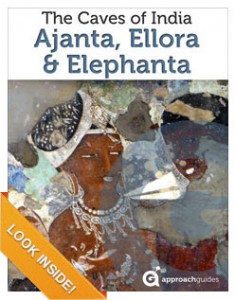
Travel guidebook summary
Built by Buddhist, Hindu, and Jain monks as mountain retreats, India’s magnificent rock-cut sanctuaries, monasteries, and temples offer travelers an unrivaled cultural experience, transporting them back to the formative stage of art and architecture for India’s indigenous religions.
See full description
* Guidebooks run on all digital devices and are delivered in ebook format.
These are affiliate links; as an Amazon Associate and Apple partner, Approach Guides makes a commission from qualifying purchases.
★ ★ ★ ★ ★ Excellent guidebook This guide selects the best 9 caves from Ajanta and the best 8 from Ellora for wonderfully clear, succinct commentary with highlighted diagrams, closeup photographs, and author’s tips to get the most from your visit. This guide was truly invaluable to helping me locate and appreciate the highlights of these beautiful and inspiring spiritual places. Bravo!
See more customer reviews on Amazon
Message from the author

“While the physical endeavor showcased in these caves — carving artistic and architectural forms out of solid rock — is difficult even to contemplate, the experience of seeing it first hand is indelible. For this guidebook, we chose to focus on the most striking features of the unfamiliar rock-cut aesthetic, pointing out similarities and differences among the three world-class sites.”
Ajanta, Ellora & Elephanta: About this Guidebook
Guidebook screenshots.
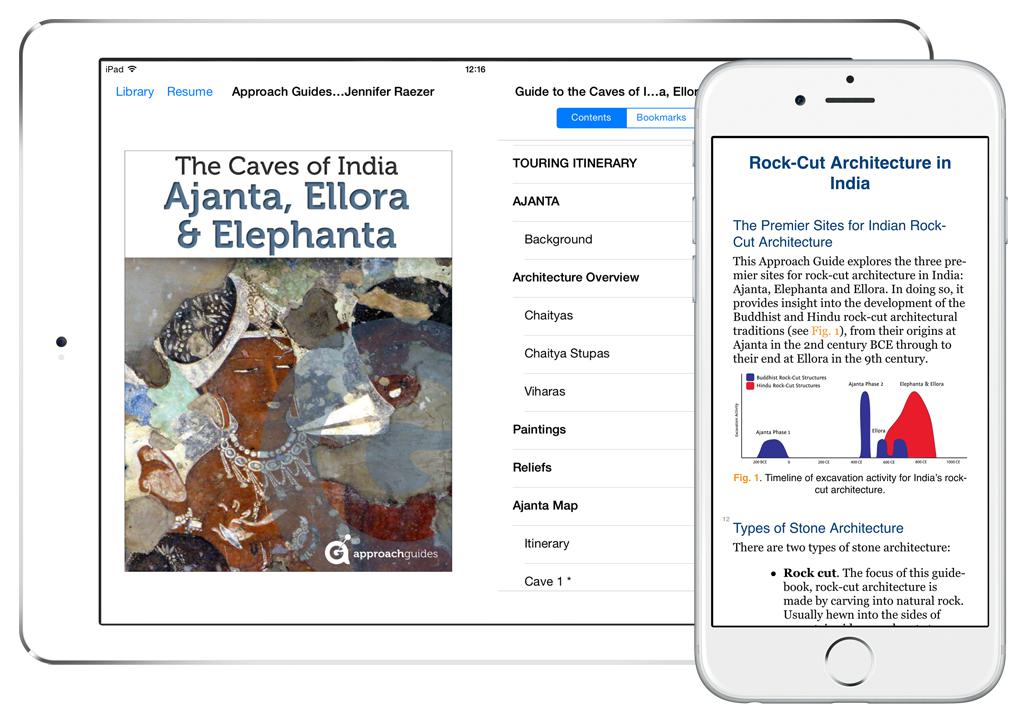
Invaluable insights
Richly detailed with powerful images
Historical context
In-depth and engaging information
Read on all digital devices
Travel information at your fingertips
Guidebook details
Built by Buddhist, Hindu and Jain monks as mountain retreats, India’s magnificent rock-cut sanctuaries, monasteries and temples offer travelers an unrivaled cultural experience, transporting them back to the formative stage of art and architecture for India’s indigenous religions.
This Approach Guide serves as an ideal companion for travelers seeking a deeper understanding of this fantastic landscape, profiling India’s three premier rock-cut religious sites: Ajanta (Buddhist), Elephanta (Hindu) and Ellora (a mixture of Buddhist, Hindu and Jain).
What’s in this guidebook
- Comprehensive look at rock-cut art and architecture . We provide an overview of India’s rock-cut art and architecture, isolating trademark features that you will see again and again as you make your way through Ajanta, Elephanta and Ellora. To make things come alive, we have packed our review with high-resolution images.
- A tour that goes deeper on the most important sites . Following our tradition of being the most valuable resource for culture-focused travelers, we offer detailed tours of the most impressive and representative caves at Ajanta, Elephanta and Ellora, walking step-by-step through their distinctive artistic and architectural highlights. For each, we present information on its history, a detailed plan that highlights its most important architectural and artistic features, high-resolution images and a discussion that ties it all together.
- Advice for getting the best cultural experience . To help you plan your visit, this guidebook supplies logistical advice, maps and links to online resources. Plus, we give our personal tips for getting the most from your experience while on location.
- Information the way you like it . As with all of our guides, this book is optimized for intuitive, quick navigation; information is organized into bullet points to make absorption easy; and images are marked up with text that explains important features.
Introduction
Rock-Cut Architecture in India
TOURING ITINERARY
Architecture Overview
Chaityas Chaitya Stupas Viharas Paintings Reliefs
Ajanta Map Itinerary Cave 1 * Cave 2 * Cave 4 Cave 9 Cave 10 * Cave 16 * Cave 17 * Cave 19 * Cave 26 *
Background Map and Itinerary The Cave’s Layout Reliefs Overview
Reliefs Style
Featured Reliefs
1. Ravana Shakes Mount Kailasa 2. Shiva and Parvati Gambling 3. Androgyne 4. Sadashiva * 5. Ganges Descends to Earth * 6. Marriage of Shiva and Parvati * 7. Shiva Slays Andhaka * 8. Nataraja * 9. Lord of Yogis
Buddhist Caves
Cave 5 – Maharwada Cave 10 – Vishvakarma * Cave 12 – Tin Tal
Hindu Caves
Cave 15 – Dashavatara * Cave 16 – Kailasa * Cave 21 – Rameshvara * Cave 29 – Dhumar Lena
Cave 32 – Indra Sabha *
LEGACY CONTINUES: CHINA
Our Recommendations
Shopping Packing List
About Approach Guides
- Format: ebook (.mobi for Kindle; .epub for all other devices)
- ISBN: 9781936614332
- Approximate pages: 250
- Published: 2014
- Version number : 1.1
Share this Approach Guide
- Share on Facebook
- Share on Twitter
- Share on Google+
- Share on Pinterest
- Share by Mail


Planning A Trip To The Ajanta Ellora Caves
- Historical Places
- Travel Tips
- May 24, 2019 in City Tours , Historical Places , Travel Tips
- best time to visit mumbai Famous Places in Mumbai
Are you craving for some adventure? Or do you want to take your family out to explore the ancient history of India? A trip to the Ajanta Ellora caves is what you need. It will let you get lost in a long-forgotten era that existed in Indian history. These caves is known as the historical places of maharashtra with 64 rock cuts prove the presence of impressive artistry that will bewilder and amaze at the same time. Located in close proximity to the city of Aurangabad, people from all around the world come to visit these caves for their rich historical significance and grandeur. History buffs take note!
Ajanta Ellora – An Ancient Memory
Its timeput your history caps on. The Ajanta Ellora caves are located at two different sites, although within the same region, which leaves you a lot of ground to explore. The Ajanta caves history states that they were made between the second century BCE till 650 or 480 CE, whereas those of Ellora were made between the 5 th century CE and 10 th century CE. But that’s just the data.
These are UNESCO World Heritage Sites and you will love how the caves have retained their allure over innumerable years. You will be intrigued by the sheer craftsmanship on offer and come to think of it- they were supposedly crafted only by hand in those times with just a chisel and hammer for support! This is perhaps the most remarkable aspect of the caves.
Location & Ways To Reach
Ajanta Ellora caves are situated in Northern Maharashtra which is around 250 miles (400 kilometres) from Mumbai . The 2 cave sites are two hours away from each other. Not that you need to worry since they are amongst the most popular attractions in India and are thus accessible through several means of transportation. Here is a brief guide to help you explore hassle free:
- By train: The closest transportation service can be found via the Aurangabad railway stations. The caves of Ellora are only at a 45 minutes distance while those in Ajanta are 1.5 hours away. You can travel from Mumbai till Aurangabad in just 6 or 7 hours.
- By air: You can travel from your city or country to the Aurangabad airport by air. After that, the caves stand at a distance of 100 kms from the airport.
- By road: Several roads and highways connect Aurangabad to the neighbouring cities including Mumbai, Ahmedabad and Hyderabad. You may take a bus or travel in your car all the way to the caves.
After you reach Aurangabad , you can either conveniently rent a car or hire a taxi to drive you to and from the cave sites. There are daily inexpensive and guided tour buses issued by the government from Aurangabad as well that you can hop on to receive the experience of a virtual Ajanta Ellora travel guide. They are comfortable Volvo buses that are air-conditioned so no need to worry about the heat or pack dollops of sunscreen! You can book the tickets in advance at the bus stands.
Find Best Hotels In Aurangabad
Best time for a visit – Fees and timings
The best year-round visit time for the Ajanta Ellora caves is between November and March, because of the pleasant and cool weather. The region is blessed with average to heavy rainfall between June and September, making the experience delightful but full of practical snags. During the months of November till February, a moderate drop in temperature can be felt. The summer months between March and May can get really hot, especially during the daytime. It is advisable to avoid this season for a planned visit.
The Ajanta caves timings are from 9 am till 5 pm. They are open on all days except for Mondays. Entry per head for Indians is INR 35 and for foreign tourists it is INR 550. For children below 15, the charges are nil and the camera charges are INR 25. The Ellora caves remain open till 5.30 PM on all days except for Tuesdays. Entry fees are INR 40 for Indians and INR 600 for foreign tourists. The other charges are the same.
Ajanta Ellora awaits history, architecture and culture enthusiasts
What is it that binds you to your country? Your culture and its history. India showcases its most ancient of memories stored away in these caves for everyone to appreciate. The caves of Ajanta have some sophisticated and ancient paintings that can rarely be found in all of India, while the caves of Ellora are known for the extraordinary architecture they portray. The sculptures of both are worth visiting once in your lifetime.
Before coming in to visit, it might be wise to book proper accommodation near the caves. It will take you 4 to 5 hours to explore the caves in full detail. Try to be early and stay alert at all times. Save yourself from the hawkers and people who tend to charge heavily increased prices. Maintain cleanliness to abide by Government rules. This is your chance to go on a trip back in time like no other!
P.s. You might like these related resources:
- Venturing through some of Maharashtra’s most historical locations
- Point of Salvation- Mahabaleshwar Temple
- Shopping Places in Pune, the Buzzing Metropolis of Maharashtra
- SHARE THIS ON:
Leave a Reply Cancel reply
Your email address will not be published. Required fields are marked *
Book a hotel
- City Select Cities Agra Ahmedabad Alwar Amritsar Aurangabad Autumn Badrinath Bangalore Bathinda Bhopal Bhubaneswar Bihar Chandigarh Chennai Coimbatore Coorg Darjeeling Dehradun Delhi Dhanushkodi Dharamshala Dwarka Gangtok Garba Ghaziabad Goa Gujarat Gurgaon Guwahati Himachal Pradesh Himalaya Hyderabad India Indore Jaipur Jamshedpur Jodhpur Karnataka Kashmir Kedarnath Kerala Kochi Kodaikanal Kolkata Kotagiri Kullu Leh Ladakh Lonavala Lucknow Madhya Pradesh Madurai Mahabaleshwar Maharashtra Manali Manesar Mathura Mount Abu Mumbai Munnar Mussoorie Nagpur Nainital New Delhi Noida Odisha Ooty Patna Pondicherry Pune Puri Raigad Raipur Rajasthani Ranchi Rishikesh Shillong Shimla sikkim Siliguri Srinagar Surat Tamil Nadu Tawang Trivandrum Udaipur Ujjain Uttar Pradesh Uttrakhand Vadodara Varanasi
- Guests 1 Guest 2 Guest 3 Guest
Recent Posts

Best Places to Grab a Dessert in Noida

10 Cool Accessories for a Smart Traveller in 2024
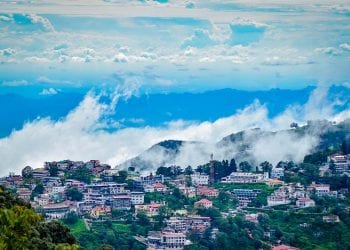
Cold-Weather Hacks: 10 Ways To Keep Yourself Warm and Healthy

Top 7 Tricks for Capturing Stunning Travel Photos
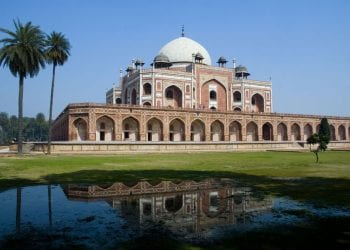
Top Solo Travel Hacks for 2024: Stay with OYO

- Cultural Tour
- tour and travel

Please rotate your device
Please go back to portrait mode for the best experience

Savaari Car Rentals Blog
Travel begins with Savaari
Top Things to do at Ajanta & Ellora Caves – A complete Travel Guide
Venture into the heart of India’s ancient artistic legacy at the Ajanta and Ellora Caves. These UNESCO World Heritage Sites in Maharashtra unfold tales from Buddhism, Jainism, and Hinduism through intricate carvings and murals. As you explore, you’ll discover that things to do in Ajanta and Ellora Caves go beyond mere sightseeing; they offer a profound journey into India’s rich cultural heritage. We recommend exploring these stunning architectural marvels by booking a comfortable chauffeur driven cab from Aurangabad .
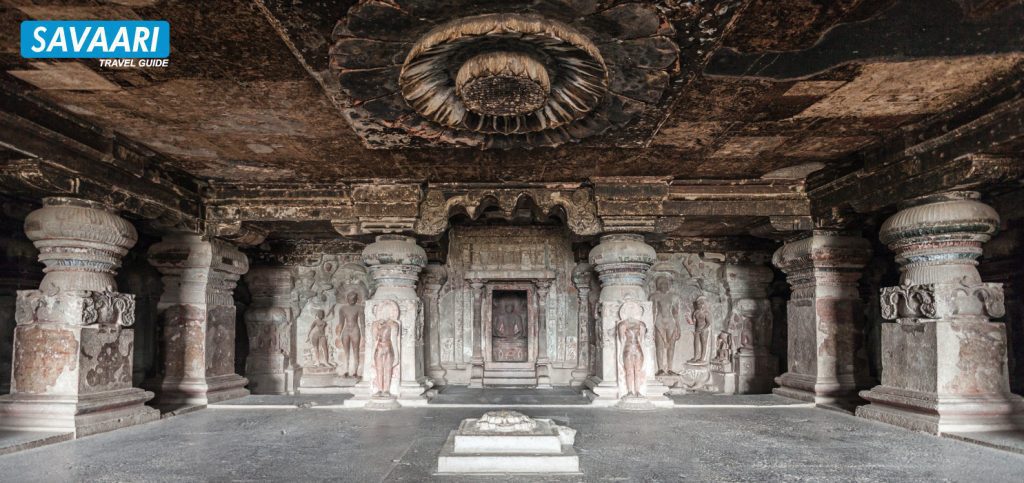
Table of Contents
- Places to eat in Ajanta and Ellora Caves
- Best time to visit
- How to reach
- Timings and Entry Fees
- Architecture
- Places to stay around Ajanta and Ellora Caves
Things to Do around Ajanta and Ellora
- Visit the Grishneshwar Jyotirlinga Temple .
- Shop at the Mughal Silk Bazaar.
- Visit the Mughal Emperor Aurangzeb’s tomb at Khuldabad
- Visit the ancient Daulatabad Fort and revel in the magnificence of the structure.
- Visit Bibi Ka Maqbara, the final resting place of Aurangzeb’s wife, Rabia-ud-Durrani . Due to its similarity with the Taj Mahal at Agra, it is also called the Mini Taj of the Deccan.
[Also read: Places to visit near Mumbai by road ]
Best Place to Eat in Ajanta and Ellora
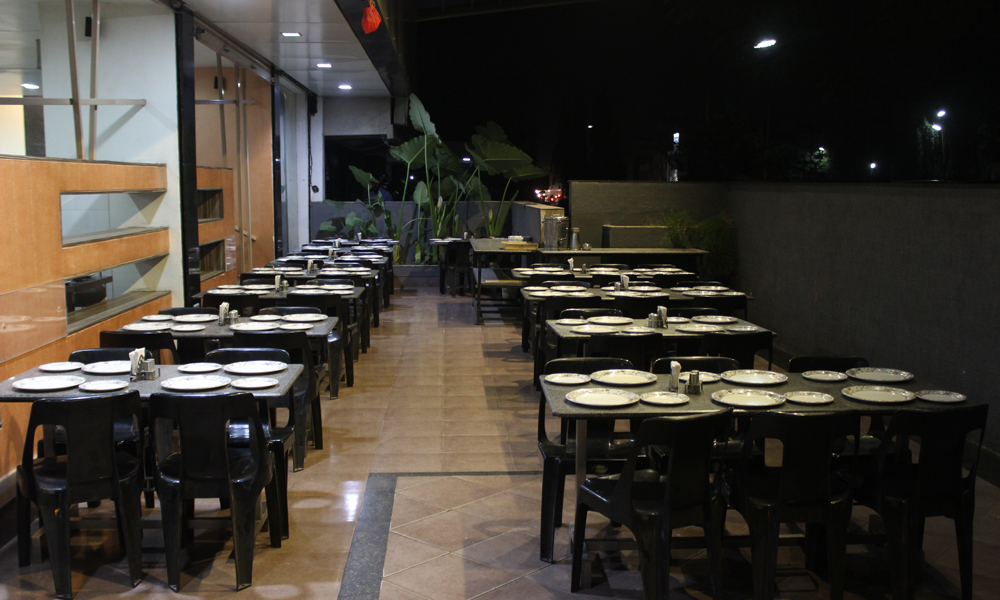
Here are some places to eat in Ajanta and Ellora:
- Bhoj Restaurant, CBS Road – Indian cuisine
- Kailash Restaurant, Railway Station Road – Indian and Chinese food
- Tandoor Restaurant and Bar, Station Road East – Indian food
- MTDC Ajanta Restaurant, Near Ajanta Caves – Thalis, juices, and more
How to Plan a trip to Ajanta Ellora Caves
Ajanta ellora caves best time to visit.
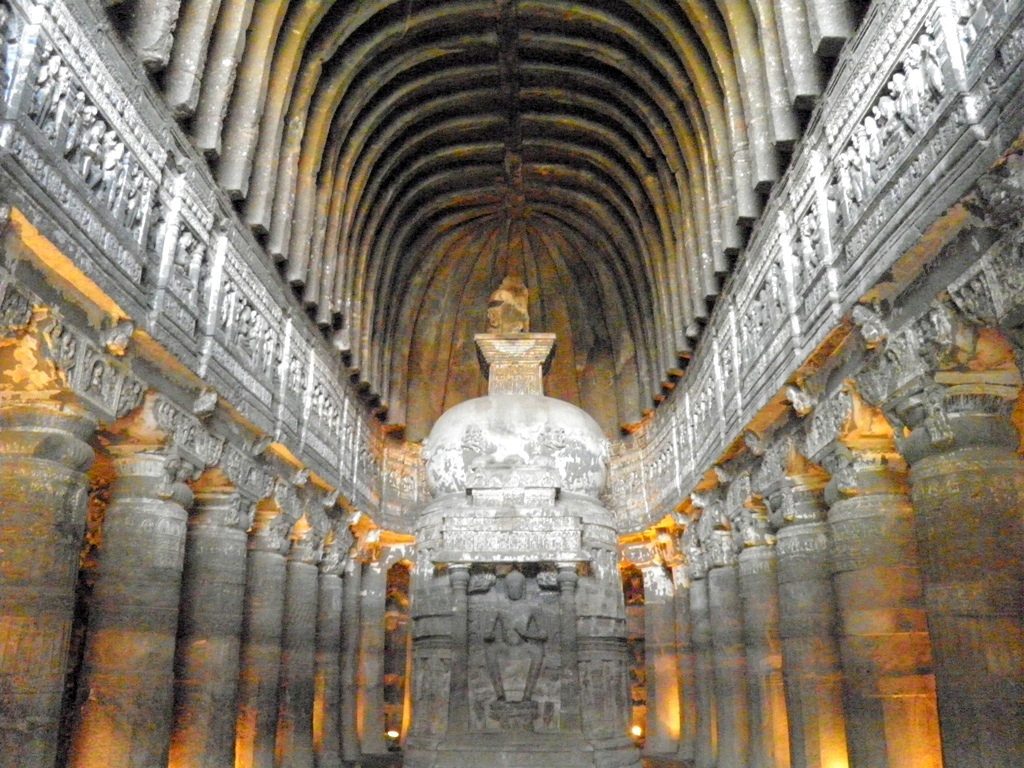
The best time to visit Ajanta and Ellora caves is from October to February. The temperatures during these months range between 10 and 25 degrees C. During the summer months of March to June the temperatures can soar to 40 degrees C. While the monsoon can be a refreshing period in Maharashtra, your trip can be hit with practical difficulties if the downpour is heavy.
Importance of a Guide during your Visit
- Every cave, painting, and sculpture in the Ajanta and Ellora has a story. Without a guide, you will not be able to appreciate their significance.
- Although you can read about it online, a local guide can take you through the temples explaining every bit in great detail.
- If you don’t know the local language, then it is important to ensure that you find a guide who knows your language.
- A knowledgeable Ajanta Ellora tourist guide can help you relive the bygone era and create memories for years to come.
#WorldHeritageDay2021 @UNESCO world heritage sites Ajanta-Ellora caves located near #Aurangabad @maha_tourism @HelloMTDC @tourismgoi pic.twitter.com/VjjGrgLxkd — Chhatrapati Sambhajinagar Aviation (@fly_high_IXU) April 18, 2021
How to Reach Ajanta and Ellora from Nashik
When traveling from Nashik, Ellora falls before Ajanta. Here are different ways in which you can reach Ajanta and Ellora Caves from Nashik:
Ajanta and Ellora Caves are situated in the Aurangabad district of Maharashtra. Aurangabad has a railway station at a distance of around 30 km from the Ellora Caves and 105 km from Ajanta Caves. There are 12 trains from Nashik to Aurangabad . The fastest train is the Dadar – Jalna Jan Shatabdi Express that takes around three hours. Once you reach the Aurangabad Railway Station, you can book a taxi from Aurangabad to Ajanta Ellora Caves and reach your destination in no time.
The distance by road from Nashik to Ellora Caves is around 170-180 km via the Maharashtra State Highway 30. The road distance between Nashik and Ajanta Caves is around 260-265 km via MH SH 25. You can drive yourself or hire a chauffeur-driven Nashik to Ajanta and Ellora Caves taxi. You can also rent a car from Pune and enjoy the journey .
There are no direct flights from Nashik to Aurangabad . Hence, it is advisable to either travel by train or road to reach Ajanta and Ellora.
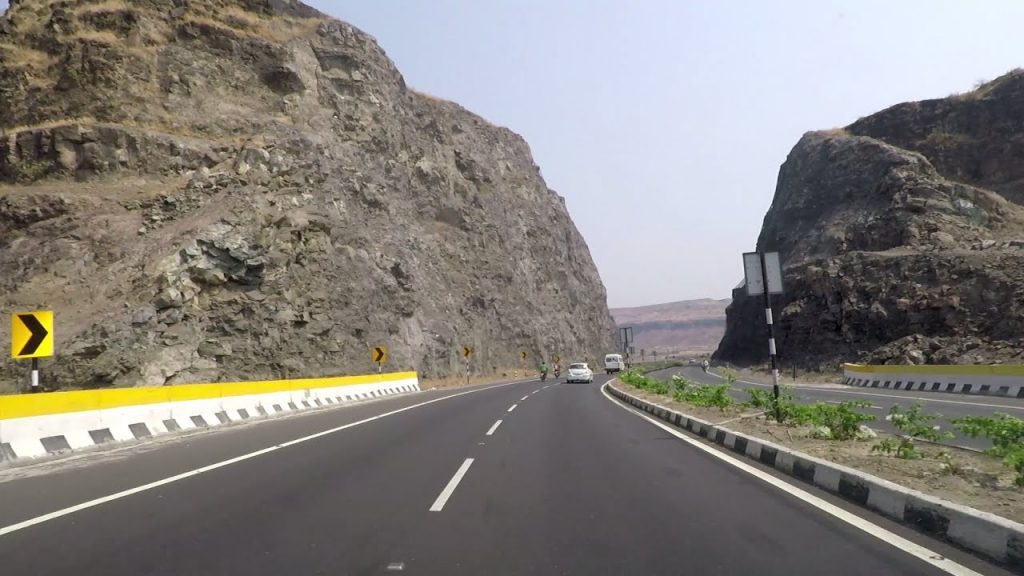
[Also Read: Explore Maharashtra’s Breathtaking Sea Forts]
How to Reach Ajanta and Ellora Caves from Mumbai
When traveling from Mumbai, Ellora falls before Ajanta. Here are different ways in which you can reach Ajanta and Ellora Caves from Mumbai:
Ajanta and Ellora are situated in the Aurangabad district of Maharashtra. Aurangabad has a railway station at a distance of around 30 km from the Ellora and 105 km from Ajanta. There are 12 trains from Mumbai CST to Aurangabad. The fastest train is the Dadar – Jalna Jan Shatabdi Express that takes around six hours and ten minutes. Once you reach the Aurangabad Railway Station, you can book a taxi from Aurangabad to Ajanta Ellora and reach your destination in no time.
The distance by road from Mumbai to Ellora Caves is around 340-345 km via the NH160 and Maharashtra State Highway 30. The road distance between Mumbai and Ajanta Caves is around 430 km via NH160. You can drive yourself or hire a chauffeur-driven Mumbai to Ajanta and Ellora caves taxi and enjoy the journey.
Aurangabad has an airport with direct connectivity to Mumbai. The flight time is around one hour and ten minutes. You can book a cab from Aurangabad airport to Ellora Caves (distance of around 36 km) or a taxi from Aurangabad airport to Ajanta Caves (distance of around 105 km).
Download our Savaari car Booking app for a smooth and pleasant journey.
Ajanta and Ellora caves timings and Entry Fees
Here are the details:
Ajanta Caves Timings
The Ajanta Caves are open from Tuesday to Sunday from 9 AM to 5 PM throughout the year. They are closed on Mondays.
Ajanta Caves Entry Fee
- Adult Indian nationals: Rs 10
- Children below 15 years of age: Free
- Foreign tourists: Rs 250
- Additional charges for still or video camera: Rs 25
Ellora Caves Timings
The Ellora Caves are closed on Tuesdays . On all other days, they are open from 6 AM to 6 PM .
Ellora Caves Entry Fee
- Indian nationals: Rs 30
- Foreign tourists: Rs 500
- Additional charges for video camera: Rs 25
- Car parking: Rs 30
About Ajanta and Ellora Caves
Ajanta Ellora caves represent the rich Indian history and artistry that existed in ancient times. These are caves that have been cut from rocks and offer a glimpse into the glorious past of our country.
Ajanta & Ellora caves are located in which city?
These caves are located in close proximity to the city of Aurangabad in Maharashtra. The Ajanta is around 102 km from Aurangabad while the Ellora Caves are around 30 km from the city.
Ajanta Ellora History
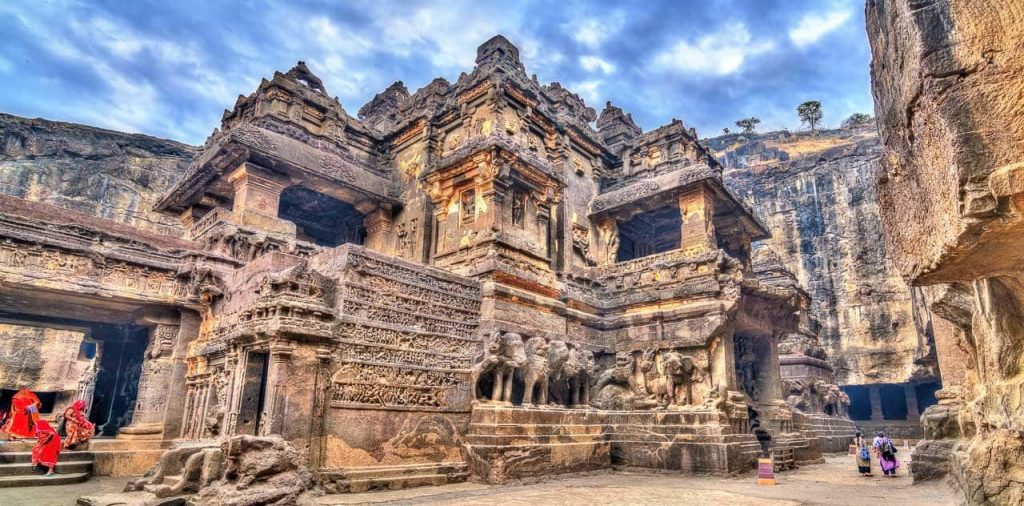
Ajanta Caves are the older of the two and date back to the period between the 2nd Century BCE and 480/650 CE . The caves are believed to have been built in two phases – the Satavahana Period and the Vakataka Period. These caves were lost to mankind since they were covered by trees and thick forest for a long period only to be rediscovered in 1819 by the British.
Ellora Caves, on the other hand, date back to the period between the 5th and 10th Century CE . They are divided into Hindu Caves, Buddhist Caves, and Jain Caves.
Today, the Ajanta Ellora Caves are a UNESCO World Heritage Site .
Ajanta Ellora Caves Architecture
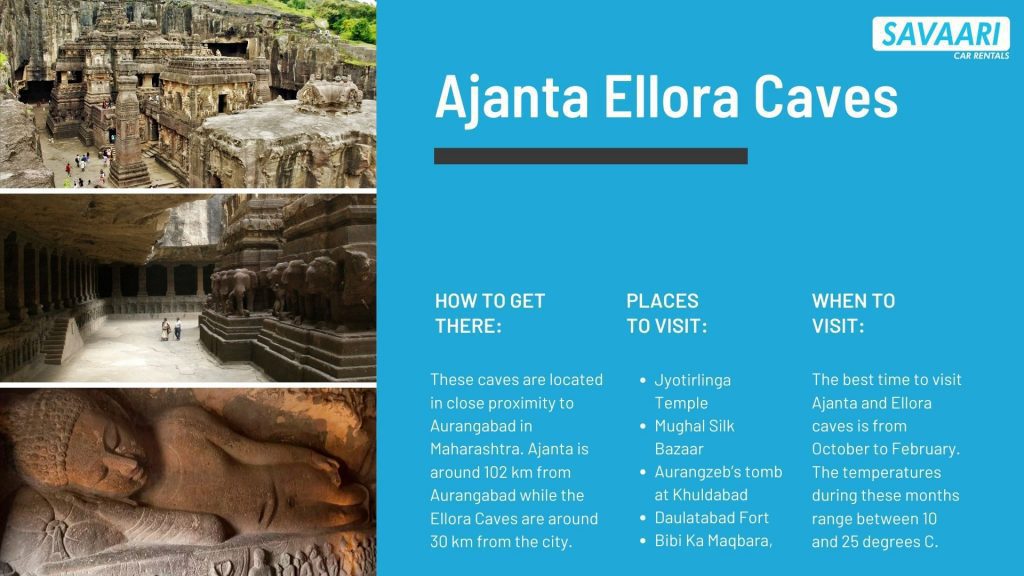
While the Ajanta and Ellora are separated by a distance of around 100 km, they are usually, mentioned together since their aesthetics are at par and they are both located in the Aurangabad district. The Ajanta Caves are more about amazing paintings on the Buddhism theme. On the other hand, Ellora Caves are more about architecture and sculpture from three different religions – Hinduism, Jainism, and Buddhism .
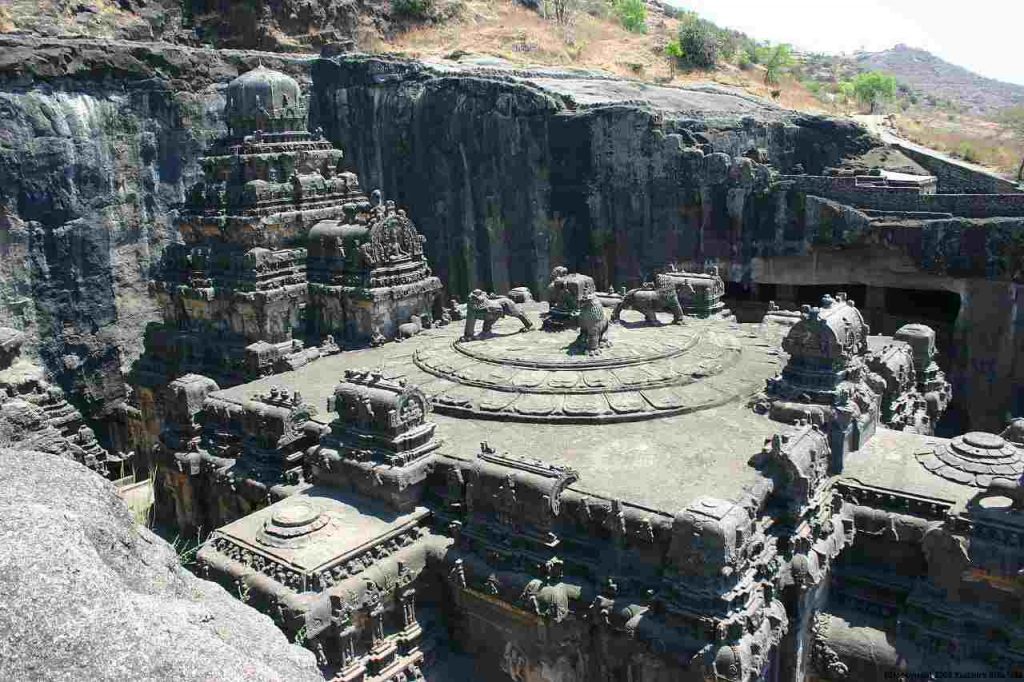
The Ajanta Caves is a cluster of around 30 caves that have been excavated in the shape of a horseshoe. All the caves were connected by a flight of stairs which have now been destroyed. Cave #1 is the most popular cave in Ajanta with authentic paintings and a doorway with Bodhisattva murals.
The Ellora Caves is a cluster of around 34 caves extending over more than 2 km. They are the most exemplary examples of Indian rock-cut architecture. These caves mostly have monasteries with living and sleeping quarters. The Buddhist Caves were built first, followed by the Hindu and the Jain caves.
Importance of Ajanta and Ellora Caves
Ajanta and Ellora are famous for the architectural finesses of ancient India.
Ajanta Ellora Caves Location – Aurangabad district in Maharashtra
These are man-made caves built by carving a huge granite hillside. Ajanta are older than Ellora. Every site has a unique story. Architecturally, they are considered to be heritage properties of the world and are listed with UNESCO as World Heritage Sites. Here are some important facts about these caves:
- The Ajanta caves date back to around the 2nd Century BCE .
- There are many monasteries and worship halls of Buddhist traditions in the Ajanta Caves.
- UNESCO believes that Indian Art was influenced by the Buddhist Art of these times.
- Ellora is one of the largest rock-cut monastery-temple cave complexes in the world.
- Ellora caves date back to the 600-1000 CE period .
- There are more than 100 caves excavated at the Ellora site. However, only 34 have been opened to the public. Of these, there are 12 Buddhist, 17 Hindu, and 5 Jain caves.
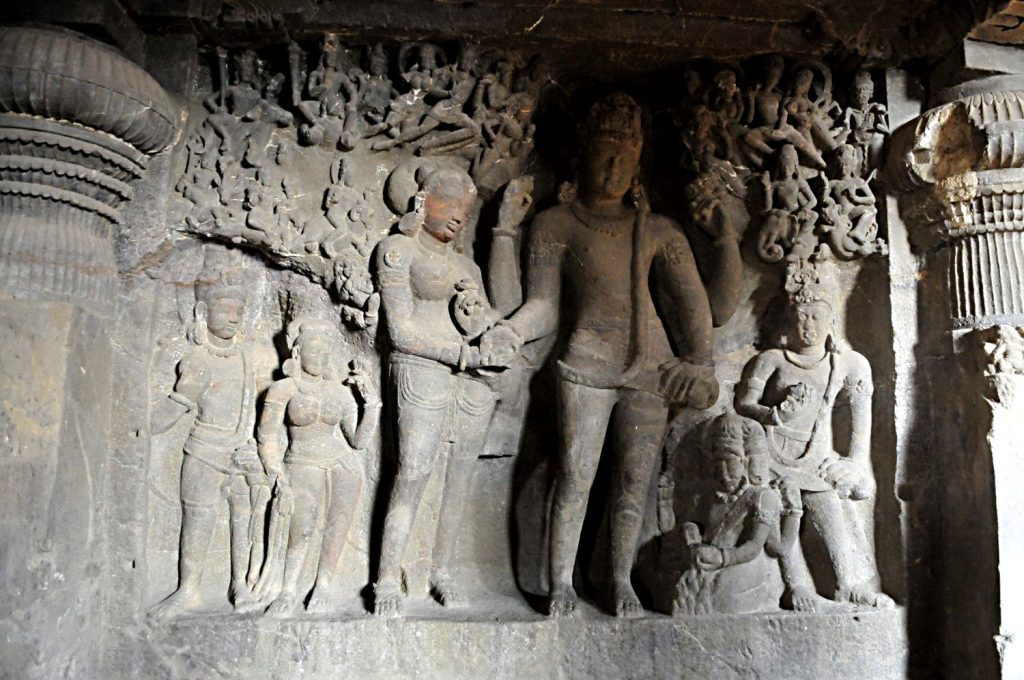
Best Places to Stay around Ajanta and Ellora
Here are some places to stay around Ajanta and Ellora:
Closer to Ellora Caves
- WelcomHotel Rama International – Member ITC Hotel Group, Airport Road
- Ambassador Ajanta Hotel, Jalna Road
- Hotel Modi Grand, Adalat Road
- The Fern Residency, Jalgaon Road
Closer to Ajanta Caves
- Hotel View Point, Jalgaon-Aurangabad Highway
- Hotel New K P Park, Fardapur
- The Imperia Residency, Ajanta Road
- Four Season Recreation Hotel And Spa, Ajanta Road
Best Road-trips to Ajanta Ellora Caves (Aurangabad District)
Last Updated on February 2, 2024 by Swati Deol
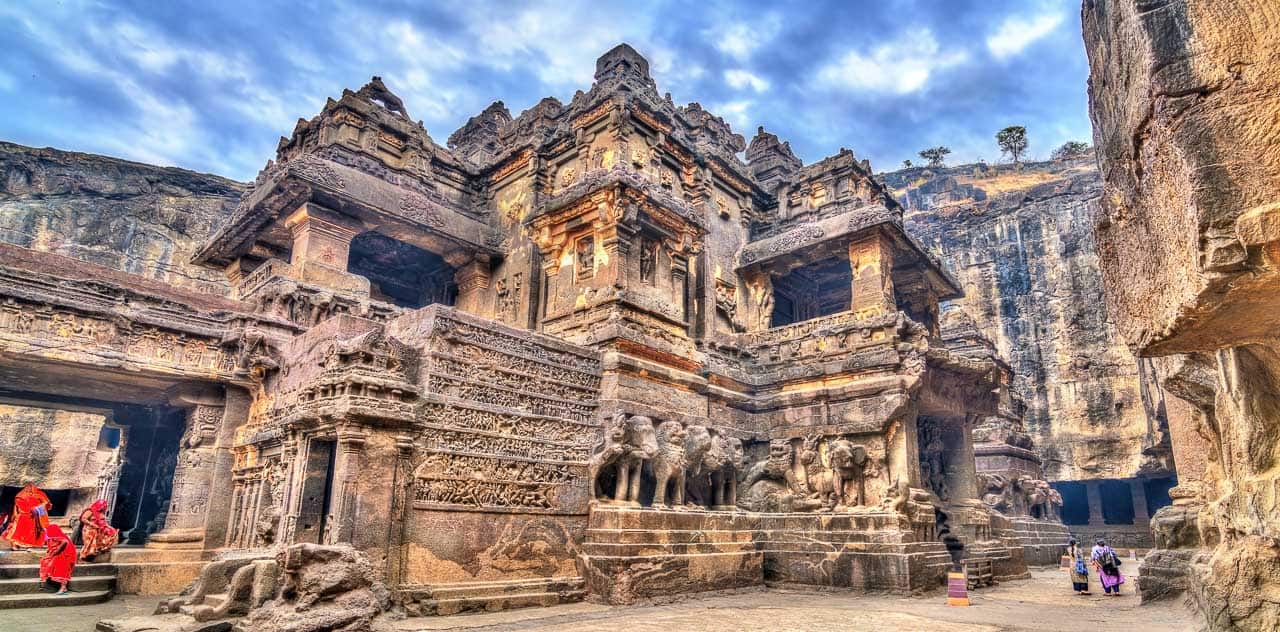
About the author
Related posts.
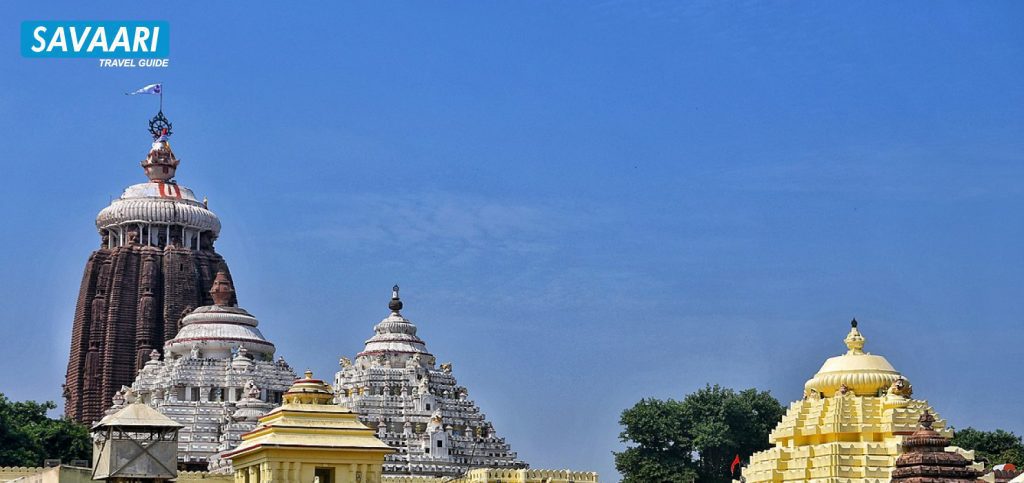
Things to do in Puri – A complete travel guide
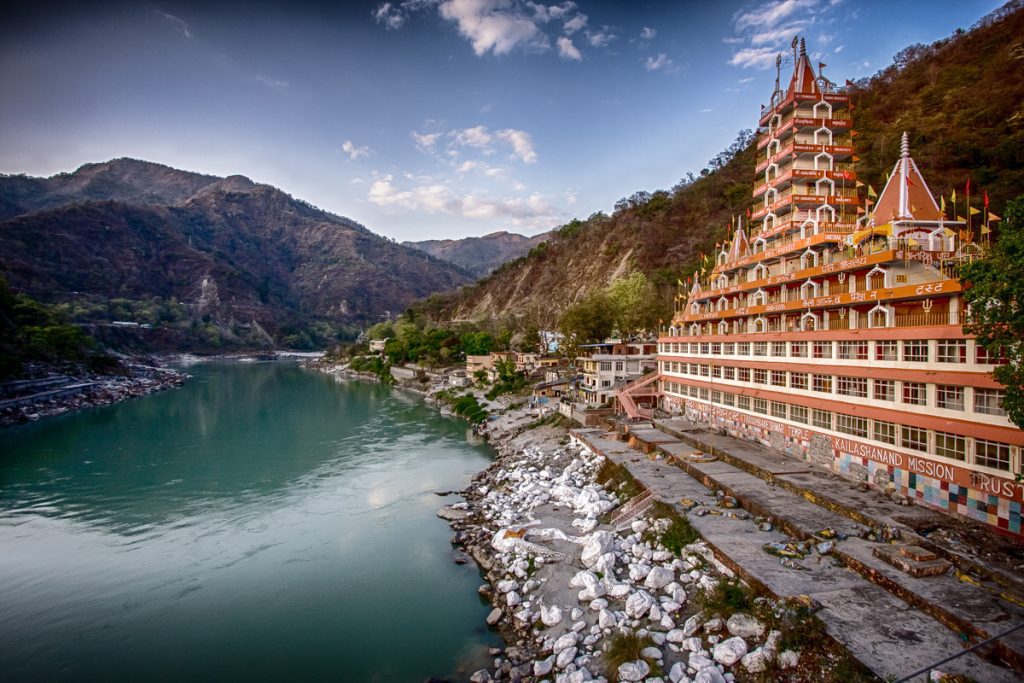
Things to do in Rishikesh – A complete travel guide
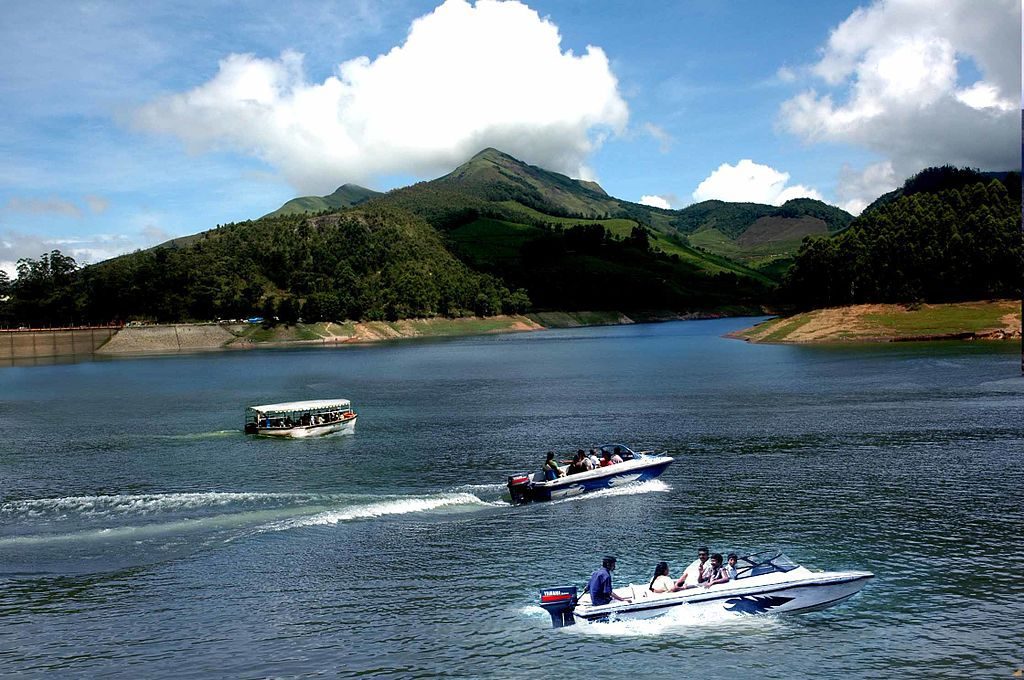
Top Things to Do in Thekkady – A complete Travel Guide
Leave a reply cancel reply.
Your email address will not be published. Required fields are marked *
Save my name, email, and website in this browser for the next time I comment.

Travel Blogs
Travel Guide to Ajanta Ellora Caves – Maharashtra
In the early 2 nd AD and later, Buddhist monks travelled from one part of the country to another, spreading the teachings of Lord Buddha. During the heavy rainy season, these monks take residence in any caves they find in the route. They spend their free time in carving the inner side of the cave into a masterpiece monastery, palace and temples. They used very primate tools for the work. These cave collections are called as Ajanta Ellora Caves. Although mentioned as a single attraction, they are two different sets of cave groups located at different regions of Maharashtra.

These caves are the symbol of architectural intellect of early Indians. It is also a pilgrimage spot, exploration site and an important tourism destination , which has paved its path to numerous itineraries of various luxury trains in the country.
What to enjoy in Ajanta Ellora Caves?
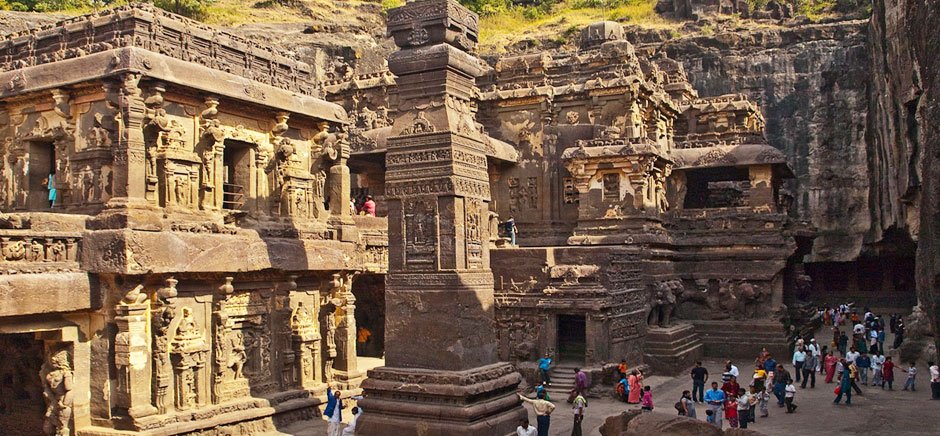
These cave groups consist of cave temples, rock-cut monasteries and other structures filled with sculptures, carvings and much more. You can find many carvings that explain the ancient culture like social activities, costumes, jewelry, gender relationship and so on. Top activities to enjoy in these heritage sites are
- Exploration or caving
- Sightseeing
- Photography
The regions around the caves are filled with small souks for souvenir shopping. You can find products like jewelry, apparels, footwear, Buddha statues, handicrafts , model of cave temples, paintings and so on.A little away from the caves, you can spot a few forts, architectural marvels, temples and others. These are located in and around Aurangabad.
Best time to visit Ajanta Ellora Caves
The cave groups are at prime beauty throughout the year. Since it is an outdoor activity, winter is the perfect time to enjoy. Maharashtra receives harsh summer with high humidity. Dehydration chances are high. Since you have to do a lot of walking and exploration, it is harder to scale the place in summer. Summer starts in March and ends in June. May is the hottest month in the region. This is also the best time to get better deals in ticket and accommodation.
Monsoon starts in July and ends in September. The place receives moderate to heavy rainfall during this season. As stated before, the activity involves long walking and outdoor activities, which might not be easier when you are drenched. It is better to avoid monsoon season unless you are on a photography trip . Monsoon washes out the caves and make the place more fresh and bright in photographs. The inner side of the caves remain unchanged throughout the year.
The weather is pleasing, seldom rains and lesser humid during winter. These reasons make the place easier to be scaled during winter. Winter starts in October or November and ends in March. November to February is the peak tourism time in this region. The only downside is that, you can find a large crowd in the heritage sites , especially during weekends and holidays.
What are the best way to reach Ajanta Ellora caves?
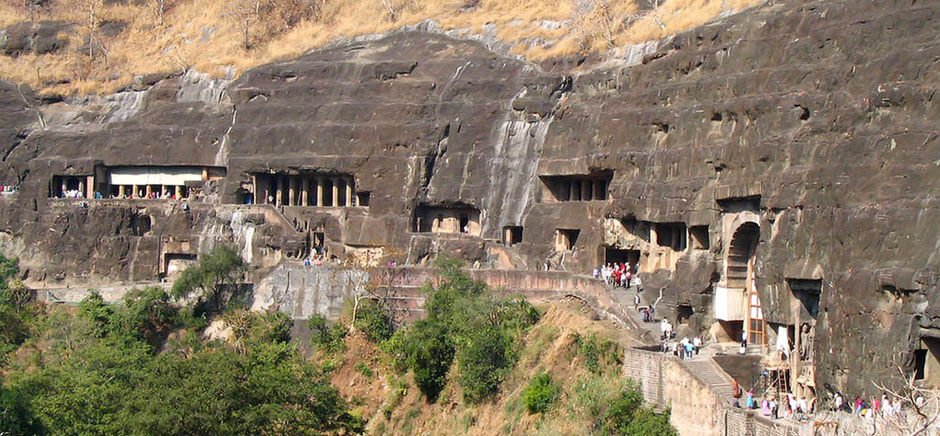
Ajanta and Ellora caves are just 30 km away from each other. Once you reach Maharashtra, you can find buses and cabs to reach the caves. Maharashtra holds one of the busiest airports in the country in Mumbai . Mumbai connects India with numerous international destinations. Mumbai is also linked with almost all major cities in the country.
The nearest railway station is located in Jalgaon Station. From the station, you can find buses, cabs and other transportation to reach Ajanta and Ellora caves. You can find direct busses to the cave regions from in and around Aurangabed. You can find buses to Mumbai from all major cities in the country. Availability of cabs depends upon the season and demand.
From Mumbai to Ajanta Ellora Caves the distance is approx. 320 kms . Know more about How to Reach Mumbai.
Read more – How to Get From Mumbai to Goa by Train
Timings and Entry fees of Ajanta Ellora Caves
Timing of ajanta caves.
- Timings : 9 am to 9:30 pm (Mondays closed)
- Entry fee : INR 10 per person (Indians), INR 250 person (foreign tourists), INR 25 per camera. Free Entry for children below 15 years old.
Timing of Ellora Caves
- Timings : From sunrise to sunset
- Entry fee : INR 10 per person (Indians), INR 250 per person (foreign tourists), INR 25 per camera
Some Important Travel Tips
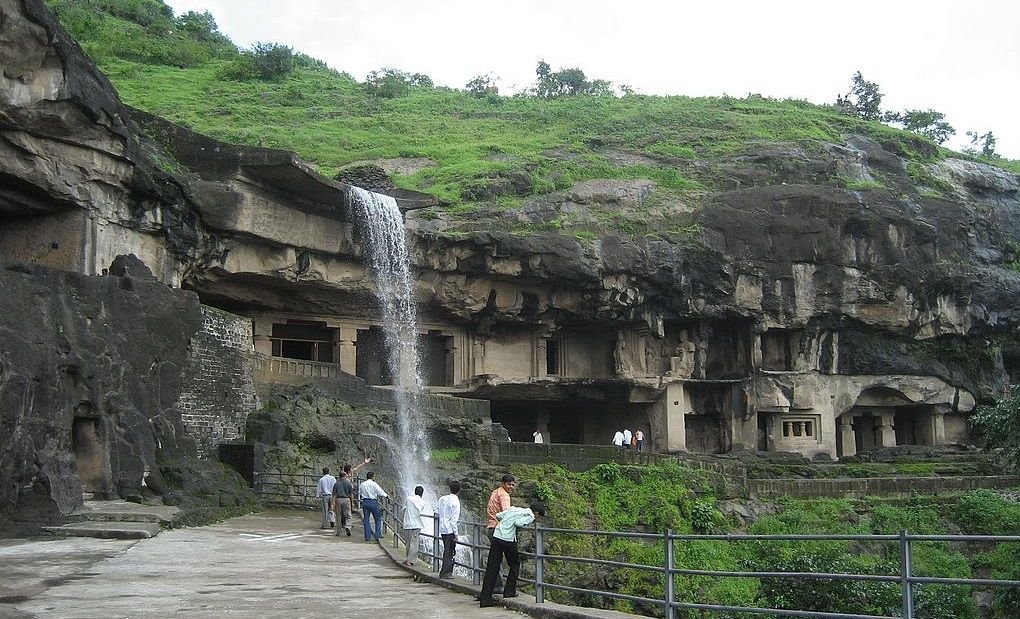
- Must visit the famous of Kailasa Temple at Ellora Caves by climbing up the hill and get excellent views.
- Please carry a torch with you because in the cave are quite dark, you are unable to see anything.
- Visit the caves in the morning so that you can avoid the crowd and enjoy the trip.
Where to stay in Ajanta Ellora Caves?
You can find boutique and budget hotels near the cave regions. If you are looking for wider options, choose hotels in Aurangabad. The demand for the accommodations near the caves is very high during tourism season. Pre-book your services as soon as possible .
Suggested articles –
- Top 7 Must Try Restaurants in Mumbai
- What You Must Know About Mumbai Airport Before Travelling?
- Top 10 Destinations Near Mumbai for Weekend Getaway
Leave a Reply Cancel reply
Your email address will not be published. Required fields are marked *
Save my name, email, and website in this browser for the next time I comment.
Best Time To Visit Ajanta Ellora Caves
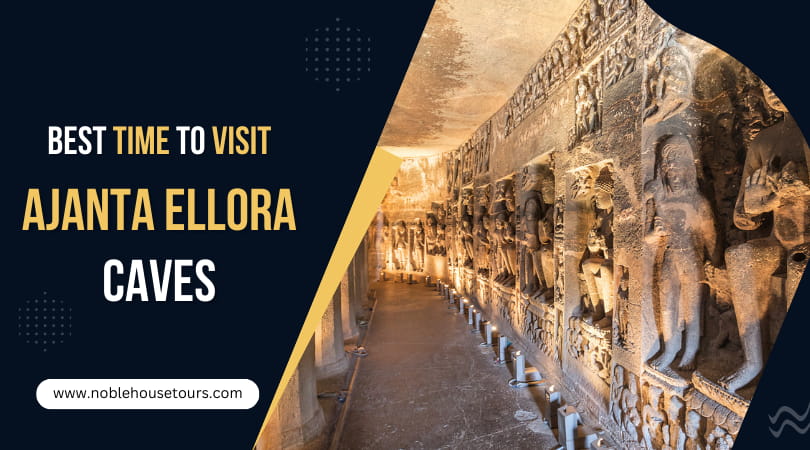
Want to make your holidays memorable and interesting with some of the most interesting and mysterious caves in India? So get ready to make the most of your vacation with Anjata and Ellora Caves, two of the most important historical and cultural caves of India located near Aurangabad, Maharashtra. These caves of Ajanta and Ellora, dating back to the 2nd century BC, are famous everywhere for their intricate carvings, sculptures, paintings, and rock-cut architecture. Ajanta and Ellora caves are the best places to spend holidays due to their unique structure. If you are curious to see the caves this time and want more information then stay tuned to this page.
Table of Contents
What Are Ajanta And Ellora Caves ? And it’s So Famous
Ellora Caves in the Aurangabad district of Maharashtra in India are famous not only in India but also abroad for their Buddhist-religious rock-cut caves. Inscriptions from the sixth century onwards have been found in these caves which describe many events in history. There are more than 100 caves at this place, out of which only 34 caves are allowed to visit and on the other hand, there are Ajanta caves which are in the Aurangabad district of Maharashtra state and are around the second century BC. These Buddhist caves date back to around 480 BC. There are 29 rock-cut sculptures and they depict important Buddhist art events of that time. Ajanta and Ellora Caves , recognized as World Heritage Sites by UNESCO, are among the tourist attractions in India.
Quick Enquiry Quick Enquiry Make A Call Call Us Chat with us Whatsapp Us
What Is The History Of Ajanta And Ellora’s Caves?
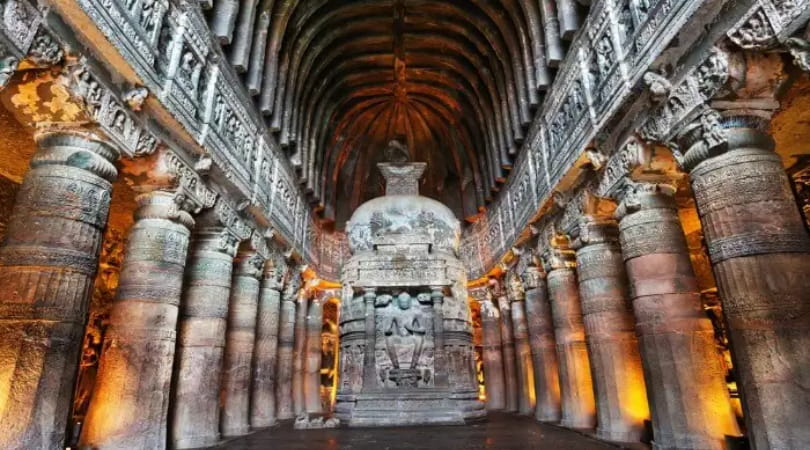
Ellora caves are counted among those monastery-temple complexes that have been constructed by cutting the biggest rocks. These caves were formed due to volcanic basalt, due to which they were named ‘Deccan Traps’. Ajanta caves are 100 kilometers away from Aurangabad while Ellora caves are located at a distance of 30 kilometers from Aurangabad. The Ajanta caves were discovered by the Satavahana dynasty and the Ellora caves by the Rashtrakutas, were both famous for their distinctive Buddha painting styles. Ajanta and Ellora caves are counted as one of the precious and important caves of India. Ajanta has 29 caves to see, while Ellora has 34 caves to see. For tourists, Ellora caves are divided into three parts Hindu caves, Jain caves, and Buddhist caves.
What Is The Best Time To Visit Ajanta And Ellora Caves During The Holidays?
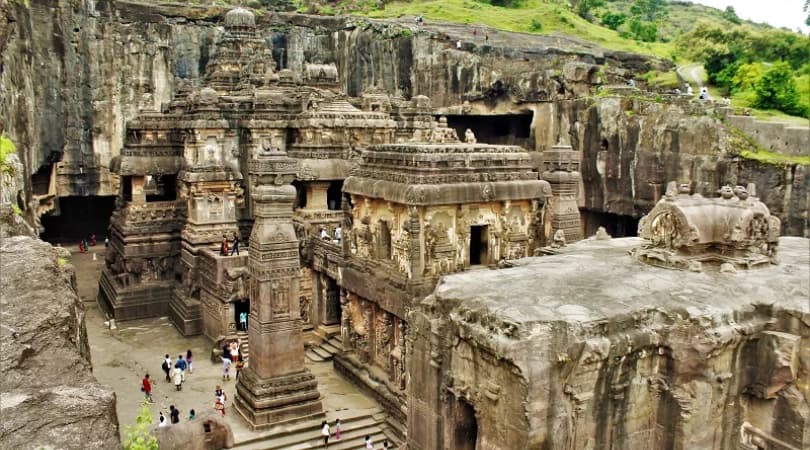
If you want to explore Ajanta Ellora Caves so visit between June to March. The region receives very heavy rainfall during the monsoon season from June to September, making visiting these Gunafoss all the more enjoyable. Whereas there is a slight difference in temperature from November to February. Whereas it would be better not to travel during the summer months of March to May as the weather can be quite hot during those days, especially during the day which can hamper your travel, hence it is advisable to miss the months between June to September.
Timinning Of Visiting These Historical Caves:
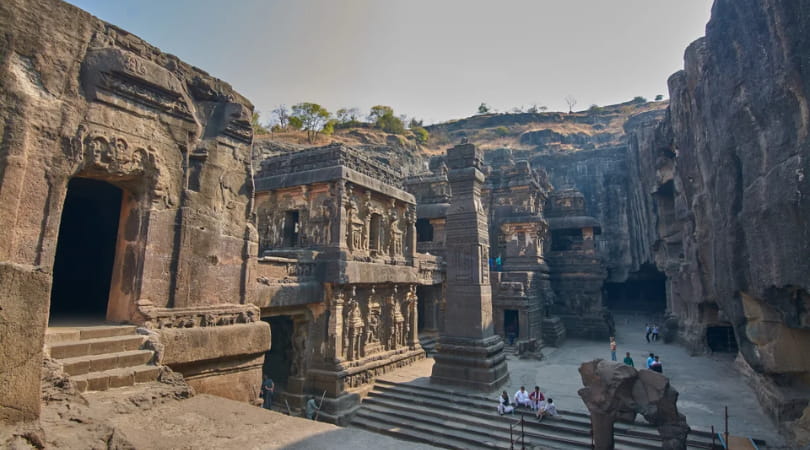
You should reach on time to visit Ajanta and Ellora caves so that you can enjoy those caves properly. Ajanta Caves are closed on Mondays and are open between 9:00 am to 9:30 am on other days. The caves of Ellora remain open all day but the real pleasure of seeing these caves comes at the time of sunrise and sunset, so whenever you go to see the Ajanta and Ellora caves , keep these things in mind.
Interesting Thing To Do In This Cave Which Makes Your Trip Memorable
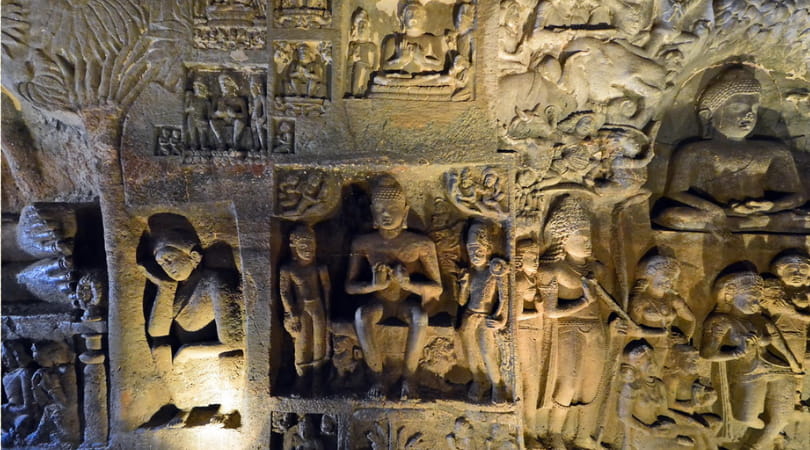
There are many interesting things to do in Ajanta and Ellora caves which will make your trip memorable . Some of the interesting things you can do are:
- Be sure to see the intricate carvings and beautiful paintings inside the caves.
- You can also learn about the history and importance of the caves from a knowledgeable guide.
- Don’t forget to take photos of the stunning architecture and natural surroundings as souvenirs
- To know the history of the caves in a different fascinating way, visit the Light and Sound Show at Ellora Caves.
- You can buy souvenirs and handicrafts made by local artisans for home decor.
Some Important Facts About These Precious Caves:
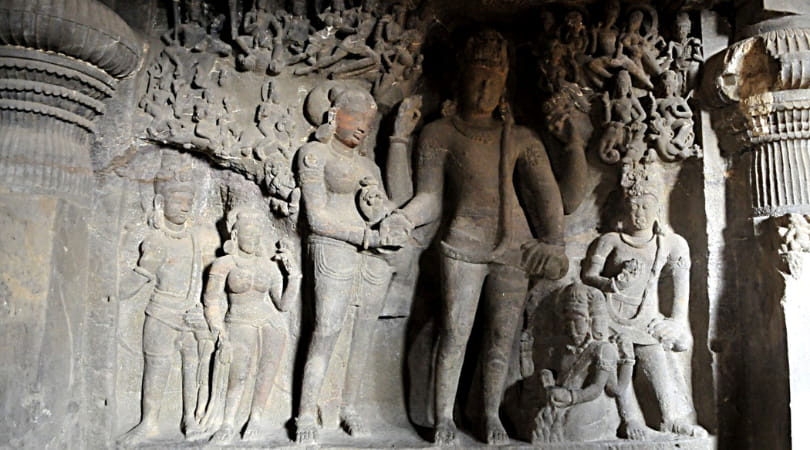
- Ellora Caves were formed from volcanic basalt formation, hence they are also known as Deccan Traps.
- Cave 15 of Ellora describes all 10 incarnations of Lord Vishnu, and the map of Cave 29 is somewhat similar to that of the Elephanta Caves.
- The sculptures found in both the caves are 600 years old but the Ajanta and Ellora caves are more than 2000 years old.
- All the paintings and carvings found in the caves depict events from the life of Lord Buddha and important stories of that time.
- After the end of Harisena’s reign, the rule of Ajanta caves also ended due to which these caves of Ajanta became hidden in the dense forests.
- one of the Most Interesting Facts About Ajanta Caves Lord Buddha did not create paintings containing his image, as he wanted his disciples to focus on education beyond materialistic desires, however, after his death, followers of his teachings created sculptures. Which highlighted the importance of pictures and knowledge. given.
Frequently Ask Question :-
The best time to visit the Ajanta Ellora Caves is during the winter months, from October to March.
October to March are the recommended months for visiting the Ajanta Ellora Caves due to the pleasant weather and minimal rainfall during this period.
During the winter months, the weather at Ajanta Ellora Caves is typically cool and pleasant, with temperatures ranging from 10°C to 25°C. The days are sunny, making it ideal for exploring the caves and surrounding areas.
Yes, the winter months from October to March are considered the peak tourist season for visiting the Ajanta Ellora Caves. During this time, the weather is favorable, and there is a higher influx of tourists.
While there are no specific events or festivals held at the Ajanta Ellora Caves during the winter months, visitors may have the opportunity to witness local cultural festivals and celebrations in nearby towns and villages.
Since the winter months are the peak tourist season, visitors can expect larger crowds at the Ajanta Ellora Caves during this time. It's advisable to plan your visit during weekdays or early mornings to avoid the crowds and enjoy a more peaceful experience.
Visitors can plan their trip to the Ajanta Ellora Caves by booking their accommodations and transportation well in advance, especially during the peak tourist season. It's also recommended to check the weather forecast before planning your visit and to arrive early in the day to avoid the crowds. Additionally, consider hiring a local guide to enhance your experience and gain insights into the history and significance of the caves.
Also Read: Losar Festival in Ladakh 2024
Follow us on, featured tour packages.

Make an Enquiry
Get in touch, get details of this tour by whatsapp or email, get quick enquiry.

Aurangabad: Ajanta and Ellora Caves Private Day Tour
Tucked away in the heart of India’s Maharashtra state, the ancient wonders of Ajanta and Ellora await the discerning traveler. This private day tour from Aurangabad promises an immersive journey through India’s rich cultural tapestry, where visitors can lose themselves in the captivating narratives etched into the caves’ stone walls. From the ethereal Buddhist frescoes of Ajanta to the awe-inspiring rock-cut temples of Ellora, each step along this guided exploration unlocks a new chapter in the country’s storied past. With an experienced guide by your side, the stage is set for an unforgettable adventure that will leave you eager to uncover more of India’s timeless treasures.
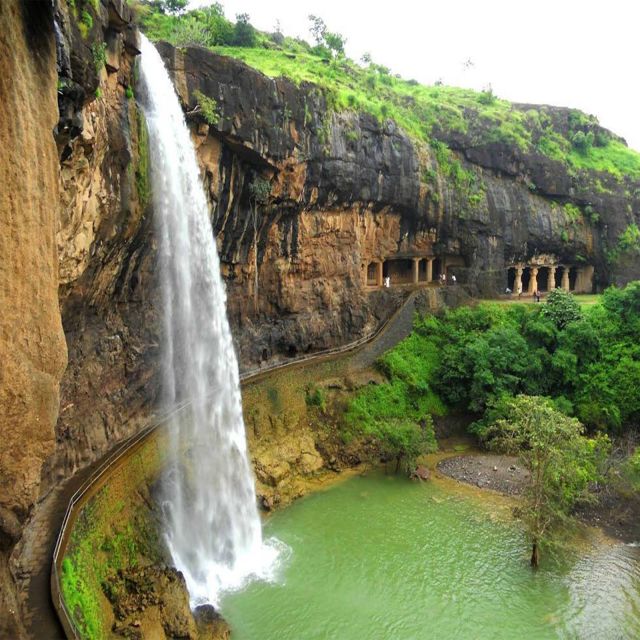
- This private day tour from Aurangabad offers an 8-hour journey to explore the renowned Ajanta and Ellora Caves, featuring ancient Buddhist art and diverse religious architecture.
- The tour includes round-trip transportation, English-speaking guide, and all entrance fees, providing a hassle-free and comprehensive experience for visitors.
- At the Ajanta Caves, guests can discover 29 rock-cut caves showcasing the evolution of Buddhist philosophy and artistic expression from the 2nd century BCE to 7th century CE.
- The Ellora Caves, a UNESCO World Heritage site, present a unique blend of 17 Hindu temples, 12 Buddhist caves, and 5 Jain temples, highlighting India’s rich religious heritage.
- The tour is rated positively for value for money and the quality of the guide and driver, making it a worthwhile cultural and historical exploration for those interested in ancient Indian civilization.
More tours and experiences nearby.
- Ajanta Ellora Caves Combo- 2 Day Guided Private Tour
- Ajanta and Ellora Caves Same Day From Aurangabad
- Day Tour of Ajanta Caves
Tour Overview
This private day tour transports visitors on an 8-hour journey to uncover the captivating Ajanta and Ellora Caves , UNESCO World Heritage sites nestled in the heart of Maharashtra, India.
Priced from ₹4,515 per person, the tour offers free cancellation and an English-speaking guide to lead the way.
Departing at 8 AM, the experience takes adventurers on a scenic 3-hour drive to the Ajanta Caves, a marvel of ancient Buddhist art and architecture.
Afterwards, the journey continues to the Ellora Caves, a complex of rock shrines representing the faiths of Buddhism, Hinduism, and Jainism.
With private transportation and included entrance fees, this immersive tour promises an unforgettable glimpse into India’s rich cultural heritage.
Itinerary Highlights
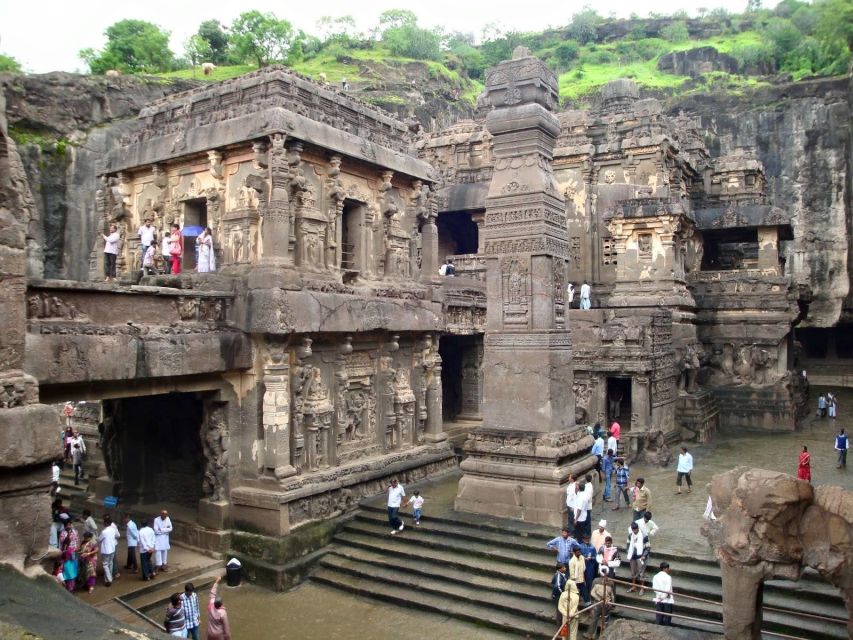
Whisking visitors away on a captivating journey, the tour kicks off with a 3-hour drive to the famed Ajanta Caves, a UNESCO World Heritage site that showcases the pinnacle of ancient Buddhist art and architecture.
Delving into the 29 rock-cut caves, explorers will encounter a mesmerizing display of ancient paintings, carvings, and sculptures that transport them back in time.
The adventure continues with a 2-hour drive to the Ellora Caves, a remarkable complex of rock shrines representing the faiths of Buddhism, Hinduism, and Jainism.
Visitors can marvel at the intricate details of the 12 Buddhist caves, 5 Jain temples, and 17 Hindu temples, each a testament to the rich cultural heritage of the region.
Uncover the beauty of ancient Indian paintings and murals
Admire the intricate rock-cut carvings and sculptures
Explore the religious diversity reflected in the Ellora Caves
Immerse in the captivating history and architecture of the sites
Ajanta Caves Exploration

The Ajanta Caves beckon visitors to uncover the magnificent relics of Buddhist art and culture , a captivating journey through India’s ancient past.
Venturing into the 29 rock-cut wonders , one is greeted by awe-inspiring murals and intricate carvings that adorn the cave walls. The caves, carved into a horseshoe-shaped ravine, showcase the evolution of Buddhist philosophy and artistic expression, from the 2nd century BCE to the 7th century CE.
Travelers can admire the serene Buddha statues , delicate frescoes, and detailed bas-reliefs that transport them back in time. The Ajanta Caves stand as a testament to the ingenuity and spirituality of India’s bygone eras, inviting visitors to enjoy the country’s captivating cultural heritage .
Ellora Caves Discovery
Nestled alongside the Ajanta Caves, the Ellora Caves beckon travelers to uncover a captivating tapestry of ancient rock-cut wonders representing the harmonious coexistence of Buddhism, Hinduism, and Jainism.
Spanning over 95 km and a 2-hour drive from Ajanta, this UNESCO World Heritage site features a staggering 17 Hindu temples, 12 Buddhist caves, and 5 Jain temples, all carved directly into the surrounding rock formations between the 5th and 13th centuries CE.
Visitors can:
Marvel at the grand Kailasanath Temple, a colossal single-rock carving dedicated to Lord Shiva.
Explore the serene Buddhist caves, adorned with intricate sculptures and paintings.
Discover the ornate Jain temples, showcasing the architectural prowess of ancient craftsmen.
Immerse themselves in the awe-inspiring scale and intricate details of this timeless archaeological treasure.
Cultural and Historical Significance
Beyond the awe-inspiring architecture and intricate carvings, the Ajanta and Ellora Caves hold immense cultural and historical significance, serving as a testament to the rich tapestry of India’s ancient civilizations.
The Ajanta Caves showcase the artistic brilliance of Buddhist monks, who adorned the walls with vibrant murals and sculptures depicting scenes from the life of the Buddha.
Likewise, the Ellora Caves captivate visitors with their diverse religious influences , housing magnificent rock-cut temples and monasteries that seamlessly blend the philosophies of Buddhism, Hinduism, and Jainism.
Exploring these caves is like stepping back in time, allowing travelers to enjoy the enduring spirituality and ingenious craftsmanship that have shaped India’s cultural heritage for centuries.
Tour Inclusion and Pricing
A comprehensive package underpins the Ajanta and Ellora Caves tour, ensuring visitors enjoy a seamless experience from start to finish.
The tour includes a private air-conditioned car, an English-speaking guide to bring the sites to life, and convenient hotel or airport pick-up and drop-off.
Entrance fees to both the Ajanta and Ellora Caves are covered, alongside all applicable taxes, making this an all-inclusive offering.
Priced from ₹4,515 per person, the tour provides exceptional value for money, as highlighted by positive customer feedback on the quality of the guide and driver.
The tour offers:
Private air-conditioned transport
English-speaking expert guide
Entrance fees included
Hotel/airport transfers
Customer Feedback and Ratings
Customers who have experienced the Ajanta and Ellora Caves tour share a mixed bag of reviews, with an overall rating of 2.5 out of 5 stars based on two evaluations. While the value for money earns a solid 4 out of 5 rating, the quality of the guide and driver garners more positive feedback.
Adventurous explorers seeking to uncover ancient Indian culture and admire breathtaking architecture will find the tour a worthwhile experience, despite the room for improvement in certain areas.
Tour Booking and Availability
Booking the Ajanta and Ellora Caves tour is a straightforward process, with availability offered year-round.
Travelers can explore the rich cultural heritage of these UNESCO World Heritage sites through a seamless, privately guided day excursion from Aurangabad. The tour provides a comfortable, air-conditioned car, an English-speaking guide, and hotel/airport pickup and drop-off, ensuring a hassle-free experience.
Visitors can look forward to:
Marveling at the ancient Buddhist, Hindu, and Jain rock-cut temples and paintings
Appreciating the architectural prowess and intricate carvings of these historic sites
Learning about the captivating stories and significance of the Ajanta and Ellora Caves
Enjoying a seamless and immersive cultural exploration at their own pace
Frequently Asked Questions
Can i combine this tour with other attractions in aurangabad.
While the Ajanta and Ellora Caves tour is a captivating experience, visitors can certainly combine it with other attractions in Aurangabad to create a more comprehensive and adventurous itinerary. The city offers a wealth of historical and cultural sites worth exploring.
What Should I Bring for the Tour?
Bring comfortable walking shoes, sun protection, water, snacks, and a camera to capture the stunning ancient carvings, paintings, and architecture of these remarkable cave complexes. Dress in layers to accommodate the varying temperatures throughout the day.
Are There Any COVID-19 Safety Protocols in Place?
The tour provider has implemented comprehensive COVID-19 safety protocols. Travelers must wear masks, maintain social distancing, and undergo temperature checks. Sanitizers are provided, and vehicles are thoroughly disinfected between uses to ensure a safe and enjoyable experience.
Can I Customize the Tour Itinerary?
Yes, the tour can be customized to fit your preferences. Simply let the tour provider know how you’d like to adjust the itinerary, and they’ll work with you to create a personalized experience that suits your interests and needs.
Are There Any Age Restrictions or Requirements for This Tour?
There are no age restrictions for this tour, though visitors should be able to comfortably navigate the uneven terrain and numerous steps at the ancient cave sites. Children are welcome, and families will enjoy exploring these remarkable historical wonders together.
Not for you? Here's more of our most recent tour reviews happening neaby
- From Aurangabad: Private Ajanta & Ellora Caves Full-Day Tour
- From Aurangabad: 2-Day Private Ajanta & Ellora Caves Tour
- Caves in Aurangabad Private Full-day Sightseeing Tour
- From Aurangabad: Ajanta and Ellora Caves Private 2-Day Tour
- From Aurangabad: Private Tour Hampi, Badami, Ajanta & Ellora
- 3-Day Private Tour to Lonar Crater, Ajanta, and Ellora Caves
- From Aurangabad: Ajanta & Ellora Day Tour With All Inclusion
- Ajanta Caves Independent Day Trip From Aurangabad City
- From Aurangabad: Hire a Cheap Taxi Car to Visit Ajanta and Ellora
- Aurangabad Ellora Caves Sightseeing – Day Tour
- Ajanta Ellora Tour Package in Air Condition Vehicle With Driver
- Ajanta & Ellora Caves and Sightseeing 2 Days Tour
- From Aurangabad: 2 Day Tour of Ajanta & Ellora With All Inclusion
- Private 2 Days Tour: Ajanta Ellora Caves and Aurangabad City
- Most Popular 2-Day Guided Tour of Ajanta & Ellora Caves With Car
The Aurangabad: Ajanta and Ellora Caves Private Day Tour immerses travelers in India’s ancient wonders.
Visitors marvel at the breathtaking Buddhist art of Ajanta and the diverse rock-cut temples of Ellora.
With private transportation , an expert guide, and all fees covered, this enriching experience offers a comfortable journey into India’s captivating cultural legacy .
Travelers embark on an unforgettable adventure, discovering the awe-inspiring heritage that has stood the test of time.
Similar Posts

Charles De Gaulle Airport Transfers

Private Taxi: Ho Chi Minh Airport (Sgn) to My Tho
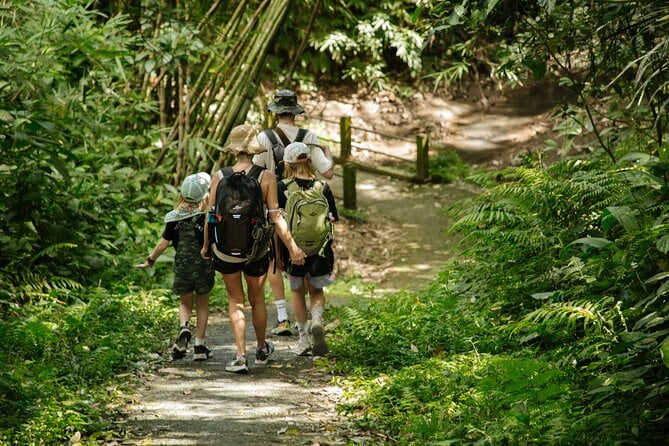
Heart of Bali, a 5-Day Walking Journey Through the Island of Gods
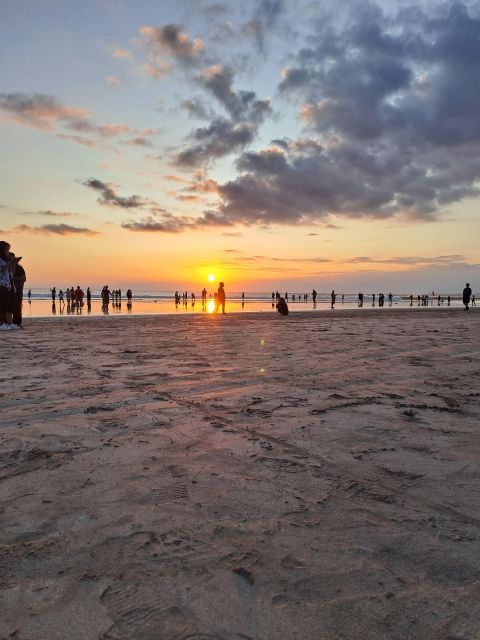
Beutiful View , Free Try Coffee and Clean Car
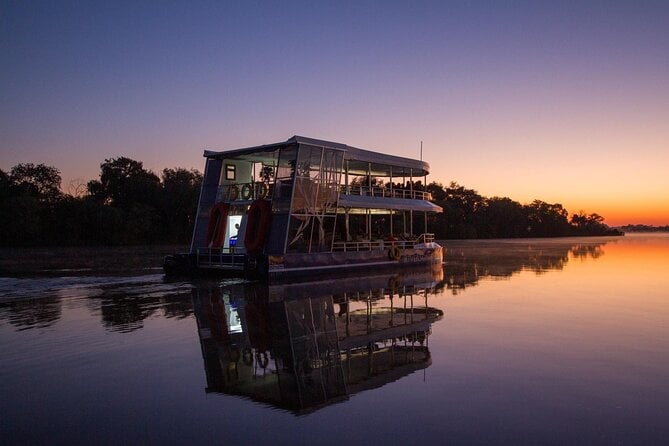
Luxury Sunset River Cruise on the Zambezi

Private Tour: Philae Temple, Aswan High Dam and Unfinished Obelisk

COMMENTS
The Ellora caves are open from sunrise until sunset (around 5:00 p.m.), daily except Wednesdays. The Ajanta caves open from 9 a.m. until 5 p.m., daily except Mondays. Both caves are open on national holidays. However, try to avoid visiting them then (as well as on weekends) as the crowds can be overwhelming and you won't have a peaceful experience.
However, Ellora Caves have always had the attention it deserves. Today, the Ajanta and Ellora Caves combine to form a UNESCO World Heritage Site, as announced on 1983. Must Read: 25 Spectacular Caves In India That Should Be Explored At Least Once. Best Time To Visit Ajanta Ellora Caves
Ajanta caves are master piece of craftsmanship & history.A must visit place for tourists. The caves are located 110 Kms away from Aurangabad town & tourists are advised to stay in the same town for nigh halts. The Caves requires full day to explore & transit.Taking a guide is highly recommended.
Although the Ajanta and Ellora caves are in the same district of Aurangabad, and in the same state of Maharashtra, they are actually quite far away from each other. The Ellora Caves are closer to the city of Aurangabad, as they are only about a 50-minute drive (32.2km) away. The Ajanta Caves, on the other hand, are located over 100kms away from ...
With the Ellora Caves, Ajanta is one of the major tourist attractions of Maharashtra.It is about 59 kilometres (37 miles) from the city of Jalgaon, Maharashtra, India, 104 kilometres (65 miles) from the city of Aurangabad, and 350 kilometres (220 miles) east-northeast of Mumbai. [8] [20] Ajanta is 100 kilometres (62 miles) from the Ellora Caves, which contain Hindu, Jain and Buddhist caves ...
How to visit Ajanta and Ellora Caves. Pin Ajanta Caves are located 100km north of Aurangabad and take almost 3 hours to reach (road conditions are variable). They are open from 9 a.m. until 5 p.m., daily except Mondays. Entry ticket is Rs. 40 per person (foreigners pay Rs. 600 pp). While you can explore the caves on your own, I recommend hiring ...
Visit Ellora Caves from Aurangabad. Similar to the Ajanta Caves, the Ellora Caves also feature ancient Buddhist artwork. Additionally, you can also find Jain and Hindu artwork at the Ellora Caves. With over 40 caves at the complex, there is plenty to see. The oldest caves date back almost 1500 years and the Ellora Caves are also UNESCO-listed.
How to Visit the Ellora Caves and Temples. We arrived at the Ellora Caves area by 14:00. It was pretty hot and pretty busy too, so we took the advice of Mr Hussein to focus our time here. Ellora is also a UNESCO World Heritage Site and combines Hindu, Buddhist, and Jain temples and caves. There are 17 Hindu caves, 12 are Buddhist and 5 are Jain.
The Ajanta Ellora caves have beautiful architecture, including paintings and sculptures of Hindu & Jain temples and Buddhist monasteries. These caves are beautifully designated as UNESCO World Heritage Sites. Ajanta caves are around 103 km north of Aurangabad city, while Ellora caves are 29.7 km north-west of Aurangabad.
The Ajanta caves are 29 in number and were built between the 2nd century BC and 6th century AD, whereas the Ellora Caves are more spread out and 34 in number and dates to the period between 6th and 11th Century AD. Ajanta and Ellora caves are designated as UNESCO World Heritage Sites and are quite popular among travelers worldwide.
The best time to visit Ajanta Ellora Caves is June to March as the pleasant weather makes the exploration a delight. Till September the region receives an average of plenty of rain showers, which also make for a beautiful day. The caves have a historical significance which attracts tons of history buffs and if you wish to connect to the past ...
Ajanta and Ellora Caves in Winter (October - February) This is the best time of the year to visit Ajanta and Ellora, as it has the best weather and celebrations. With the mercury dropping between 10°C and 25°C, the weather is pleasant. It is the perfect time to explore the caves in their entirety.
Cave 1. #1 of 14 Places to Visit in Ajanta Caves. At a distance of 350 m from Ajanta Foot Cave Bus Stop, Cave 1 is an ancient rock-cut cave situated in the cave complex of Ajanta. It is one of the best-preserved caves, and among the most popular places to visit as part of Ajanta Caves tour packages. Cave 1 is situated on the eastern end of the ...
A UNESCO World Heritage site and a protected monument under Archeological Survey of India, that boasts of being one of the largest rock-cut cave complexes that houses Hindu, Buddhist and Jain temples are the magnificent Ajanta and Ellora Caves!. Located 350 kms from Mumbai these famous rock-cut caves are situated in the hilly terrain of Aurangabad district, which is also the largest city in ...
#While studying Indian history during school days, Ajanta and Ellora Caves were one of the famous topics. Ajanta Caves date back to 2nd century. These Buddhist cave monuments were discovered by an Army Officer of the British Army on one of his hunting expeditions. It became a world famous finest example of Indian art, specifically painting.
The Ellora Caves are located about 29 kilometres (18 miles) northwest of Aurangabad, India. The drive from Aurangabad to the Ellora Caves takes 30-45 minutes depending on the time of day. The ticket price is INR 25 for Indian nationals and INR 300 for foreigners. The caves are open from sunrise to sunset each day.
Excellent guidebook This guide selects the best 9 caves from Ajanta and the best 8 from Ellora for wonderfully clear, succinct commentary with highlighted diagrams, closeup photographs, and author's tips to get the most from your visit.
The best year-round visit time for the Ajanta Ellora caves is between November and March, because of the pleasant and cool weather. The region is blessed with average to heavy rainfall between June and September, making the experience delightful but full of practical snags. During the months of November till February, a moderate drop in ...
The best time to visit Ajanta and Ellora caves is from October to February. The temperatures during these months range between 10 and 25 degrees C. During the summer months of March to June the temperatures can soar to 40 degrees C. While the monsoon can be a refreshing period in Maharashtra, your trip can be hit with practical difficulties if ...
Famous for heritage sites, Ajanta and Ellora caves which date back to 5 th and 8 th centuries. There are 64 rock cut caves listed under UNESCO World Heritage Site. The interiors and exteriors have intricate carvings and cave paintings. Ajanta and Ellora have located 110 km and 30 km away respectively from Aurangabad.
Top things to do in Ajanta and Ellora Caves and around. Explore Buddhist culture at the 29 caves in Ajanta. Sculptures, paintings, and carvings survive as examples of ancient Indian art in these cave temples built around the 2nd century BC. Visit the Kailasa Temple at Ellora, a temple dedicated to Lord Shiva, which is made from a single piece ...
Best time to visit Ajanta Ellora Caves. The cave groups are at prime beauty throughout the year. Since it is an outdoor activity, winter is the perfect time to enjoy. Maharashtra receives harsh summer with high humidity. Dehydration chances are high. Since you have to do a lot of walking and exploration, it is harder to scale the place in summer.
These caves of Ajanta and Ellora, dating back to the 2nd century BC, are famous everywhere for their intricate carvings, sculptures, paintings, and rock-cut architecture. Ajanta and Ellora caves are the best places to spend holidays due to their unique structure. If you are curious to see the caves this time and want more information then stay ...
Tour Overview. This private day tour transports visitors on an 8-hour journey to uncover the captivating Ajanta and Ellora Caves, UNESCO World Heritage sites nestled in the heart of Maharashtra, India.. Priced from ₹4,515 per person, the tour offers free cancellation and an English-speaking guide to lead the way.. Departing at 8 AM, the experience takes adventurers on a scenic 3-hour drive ...